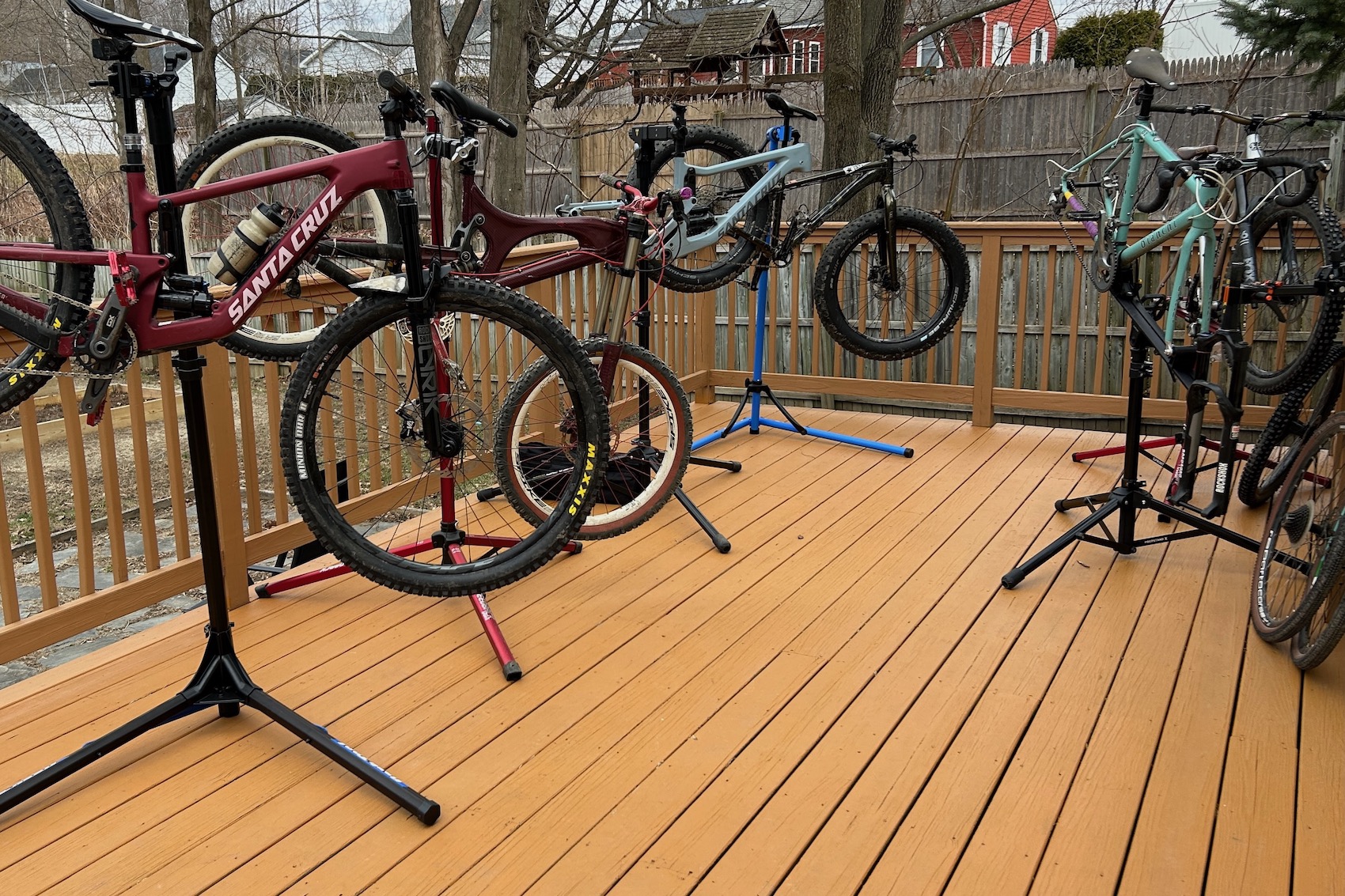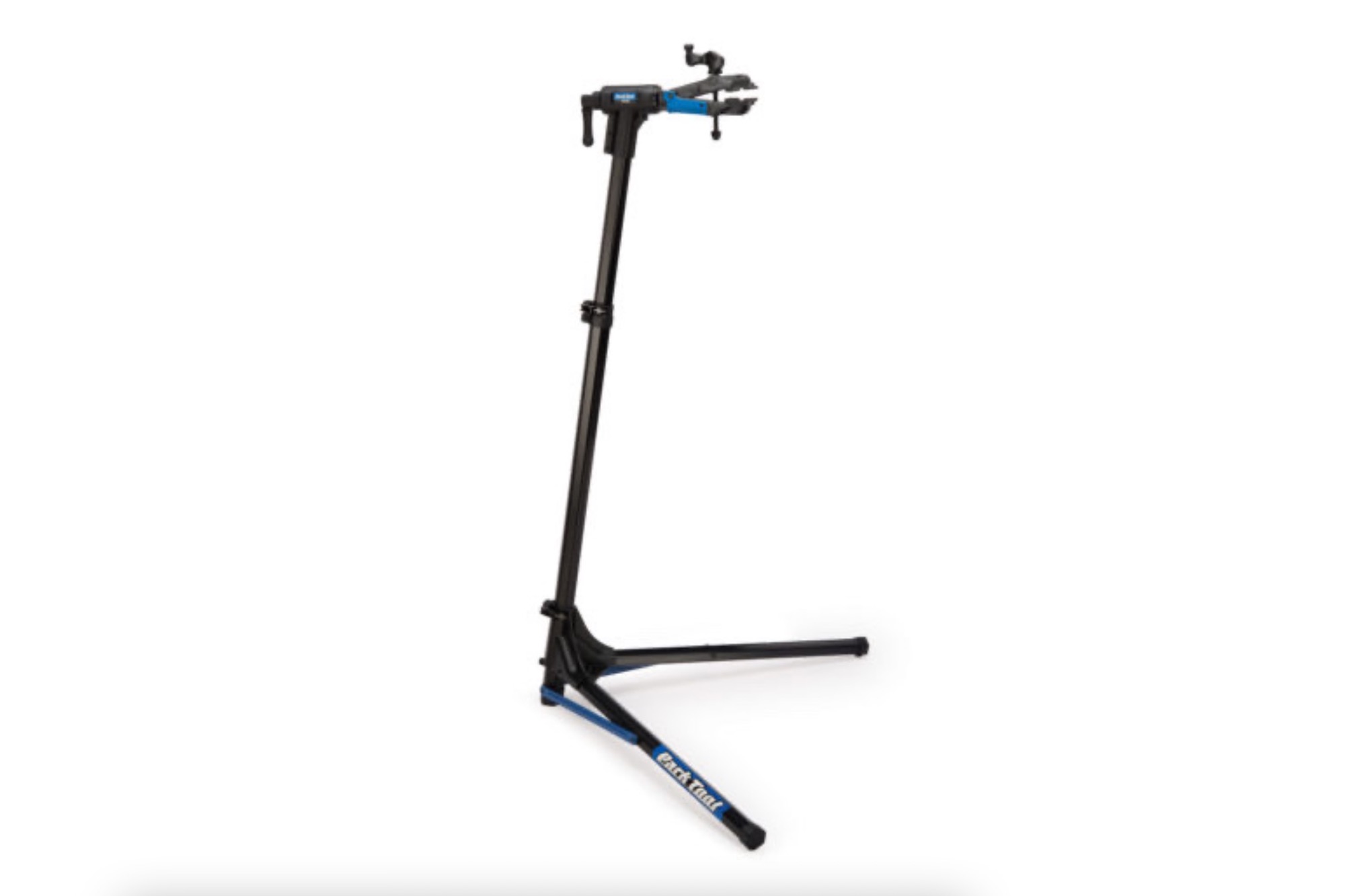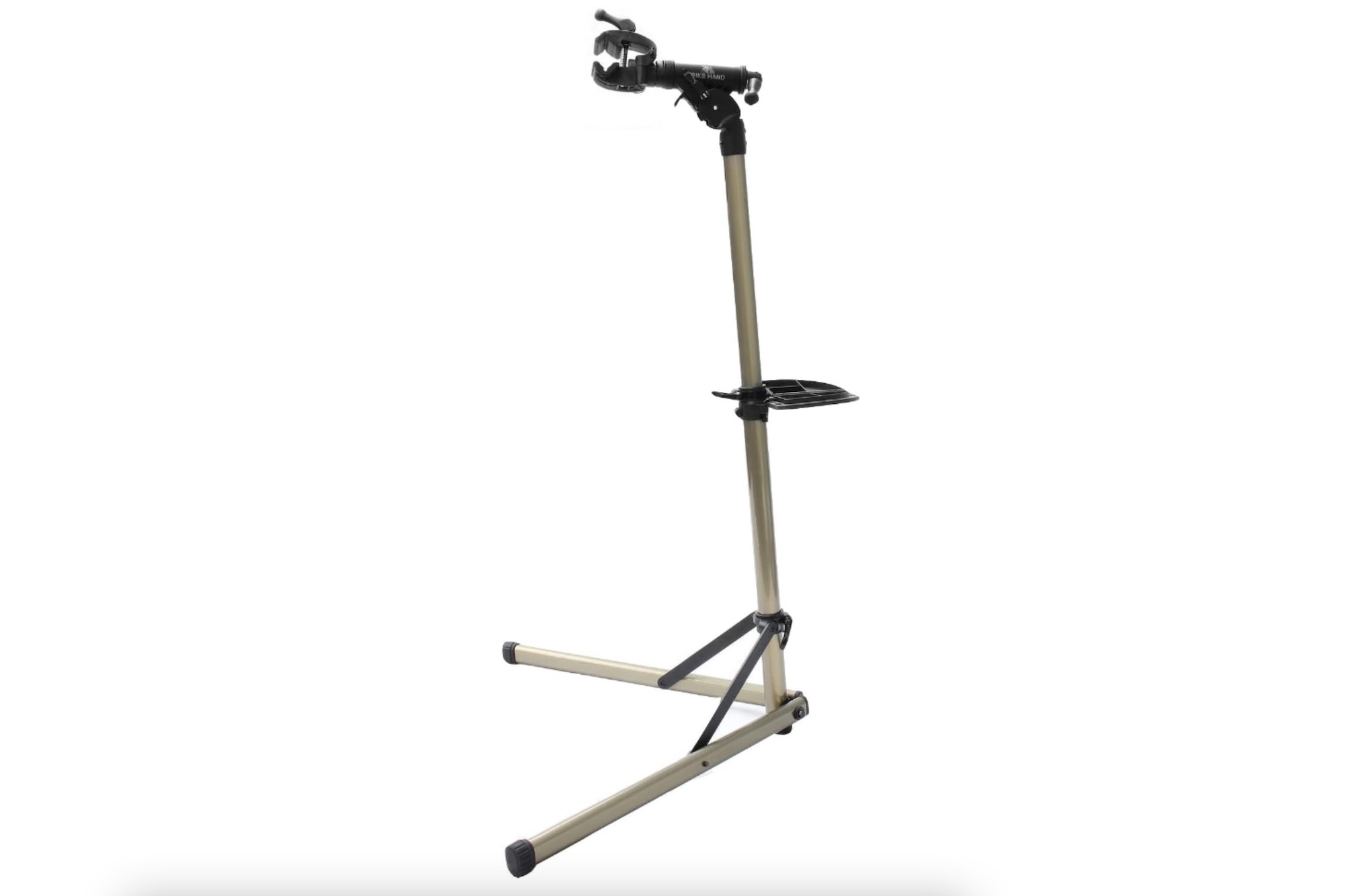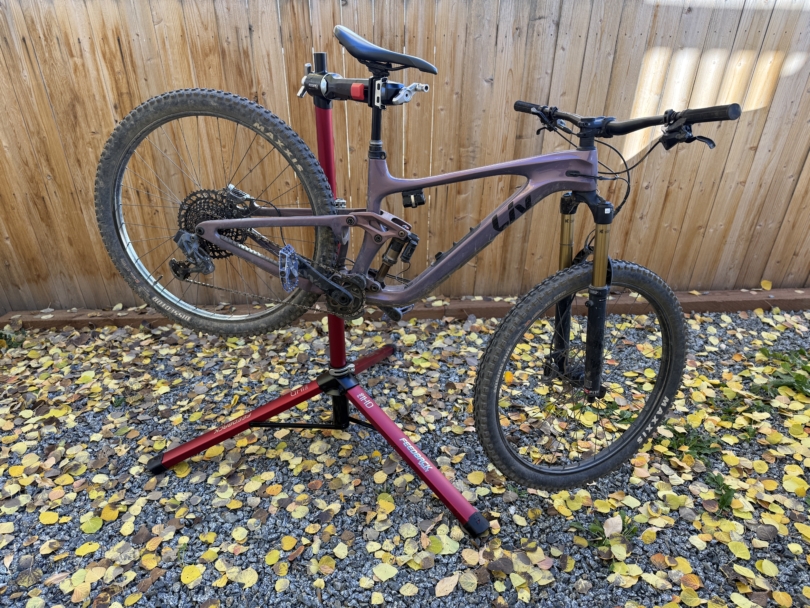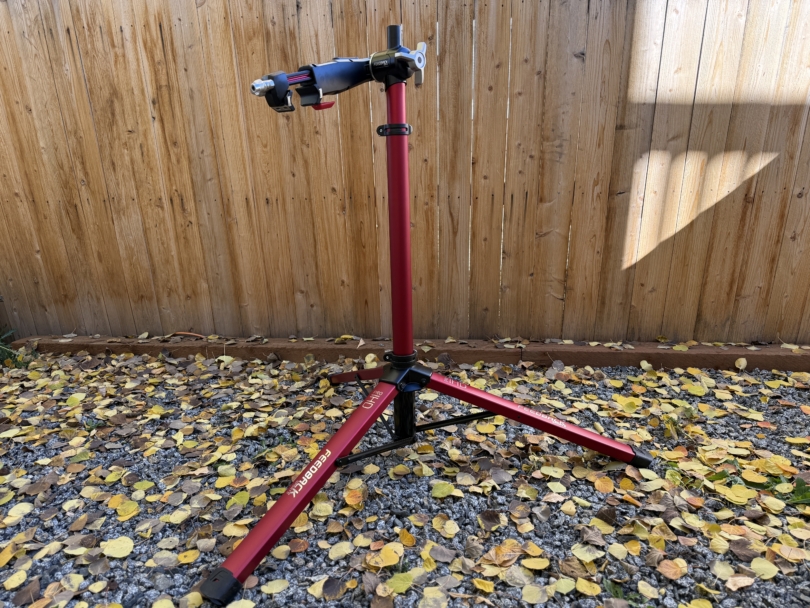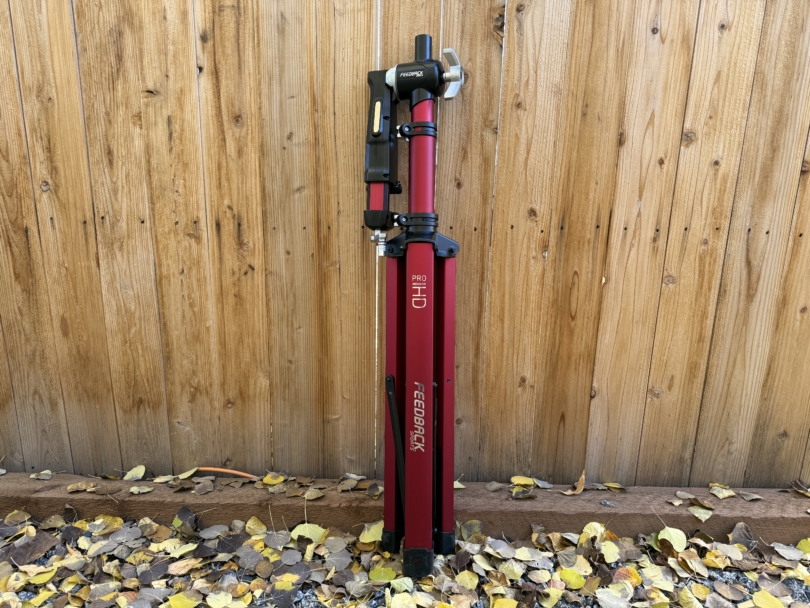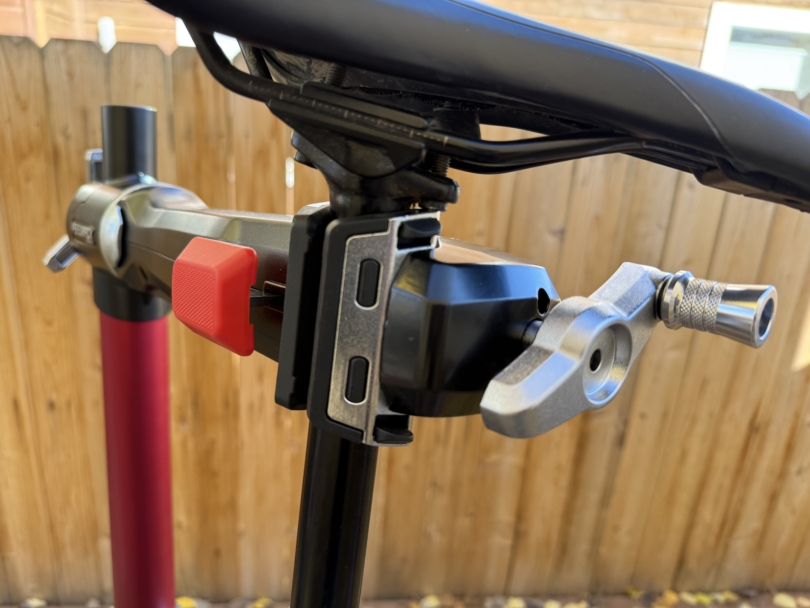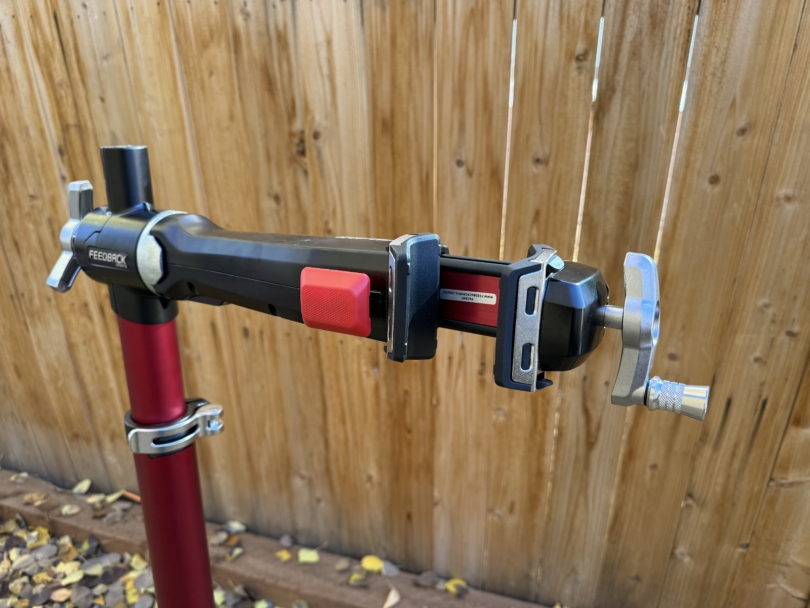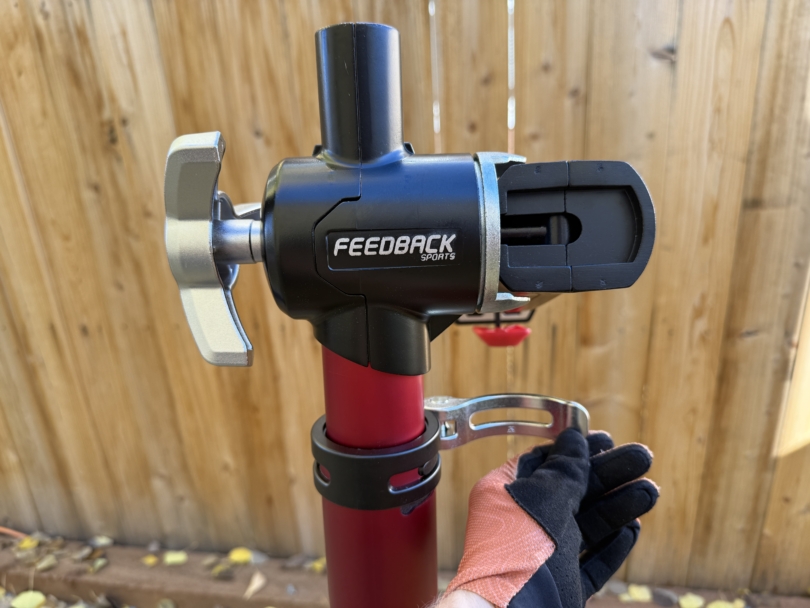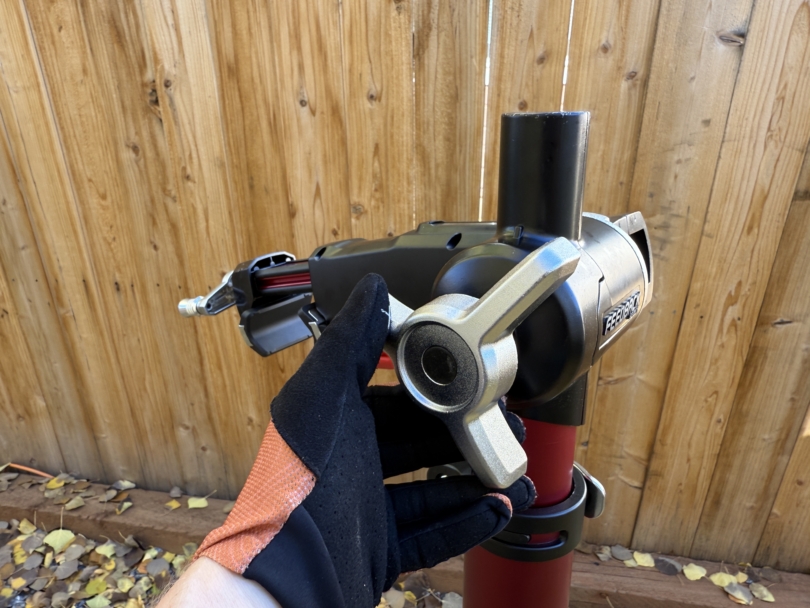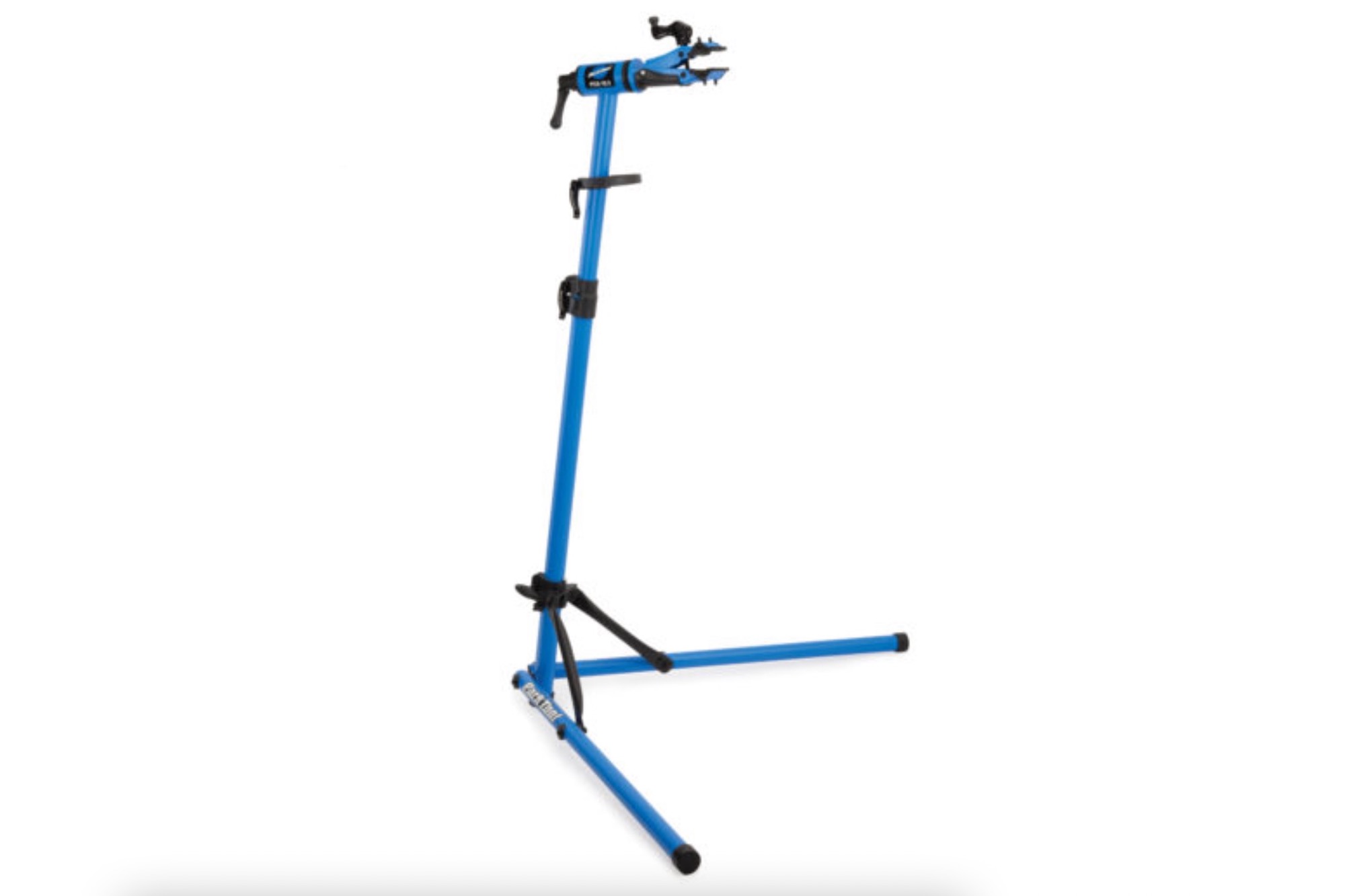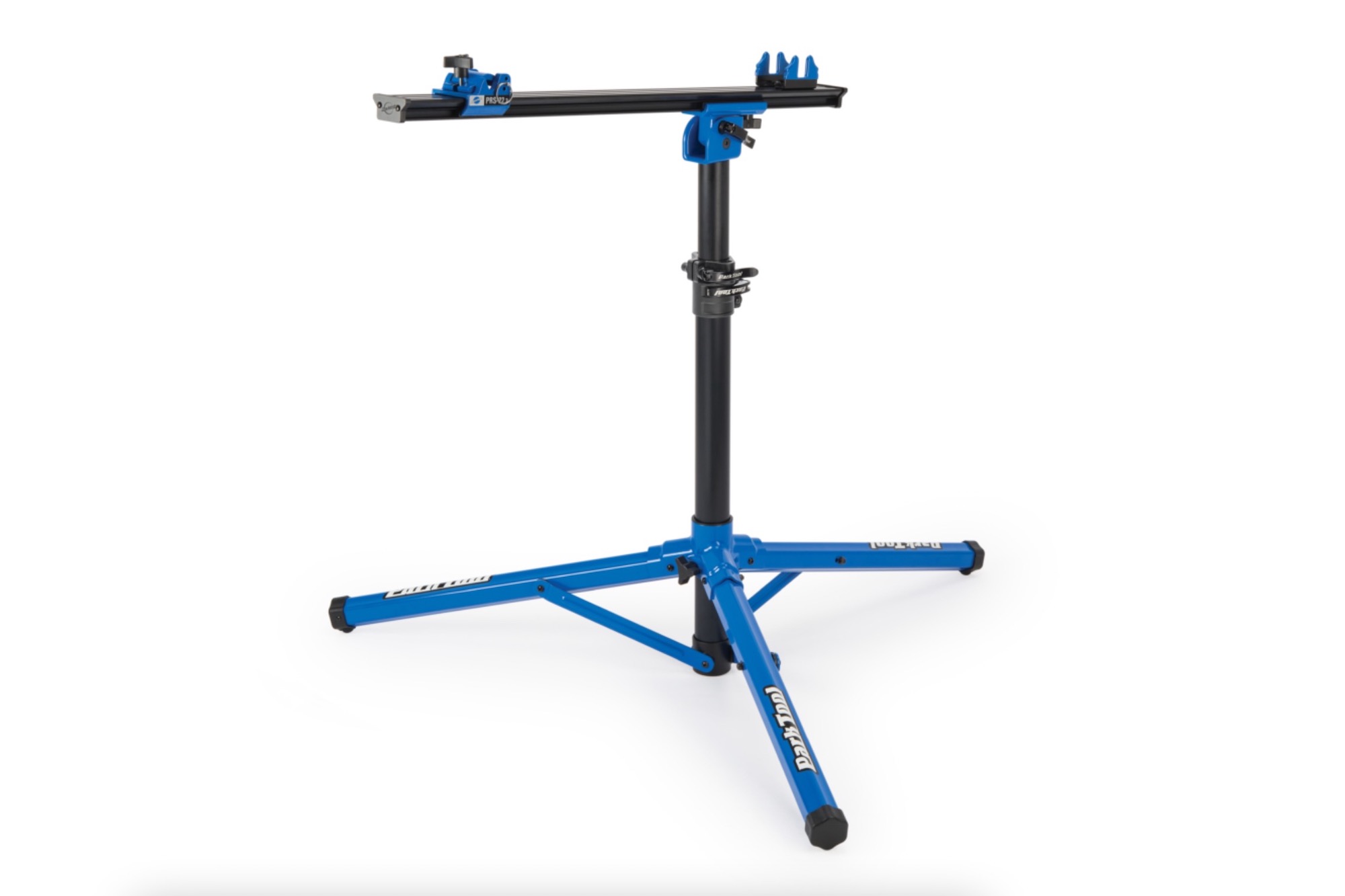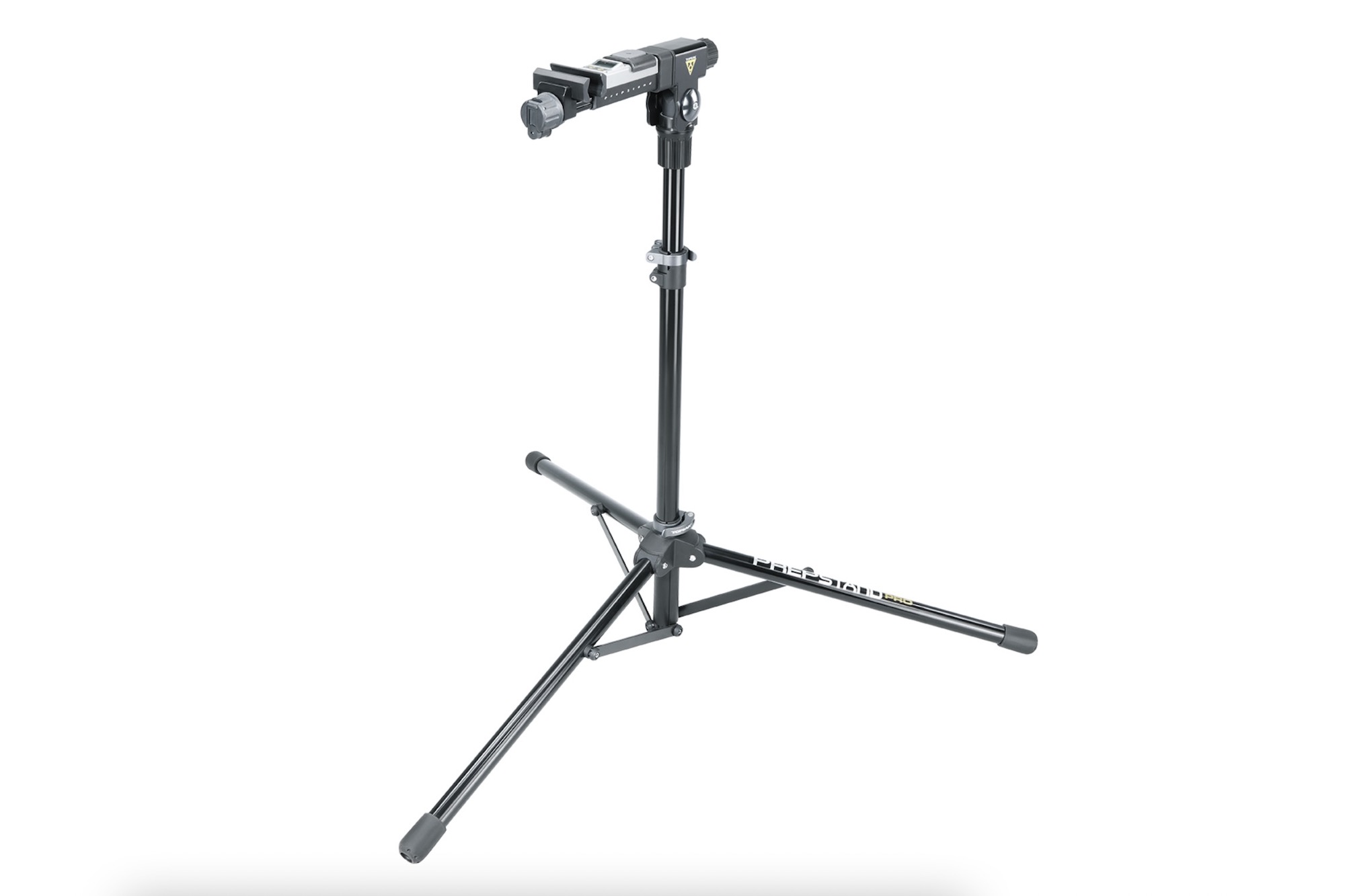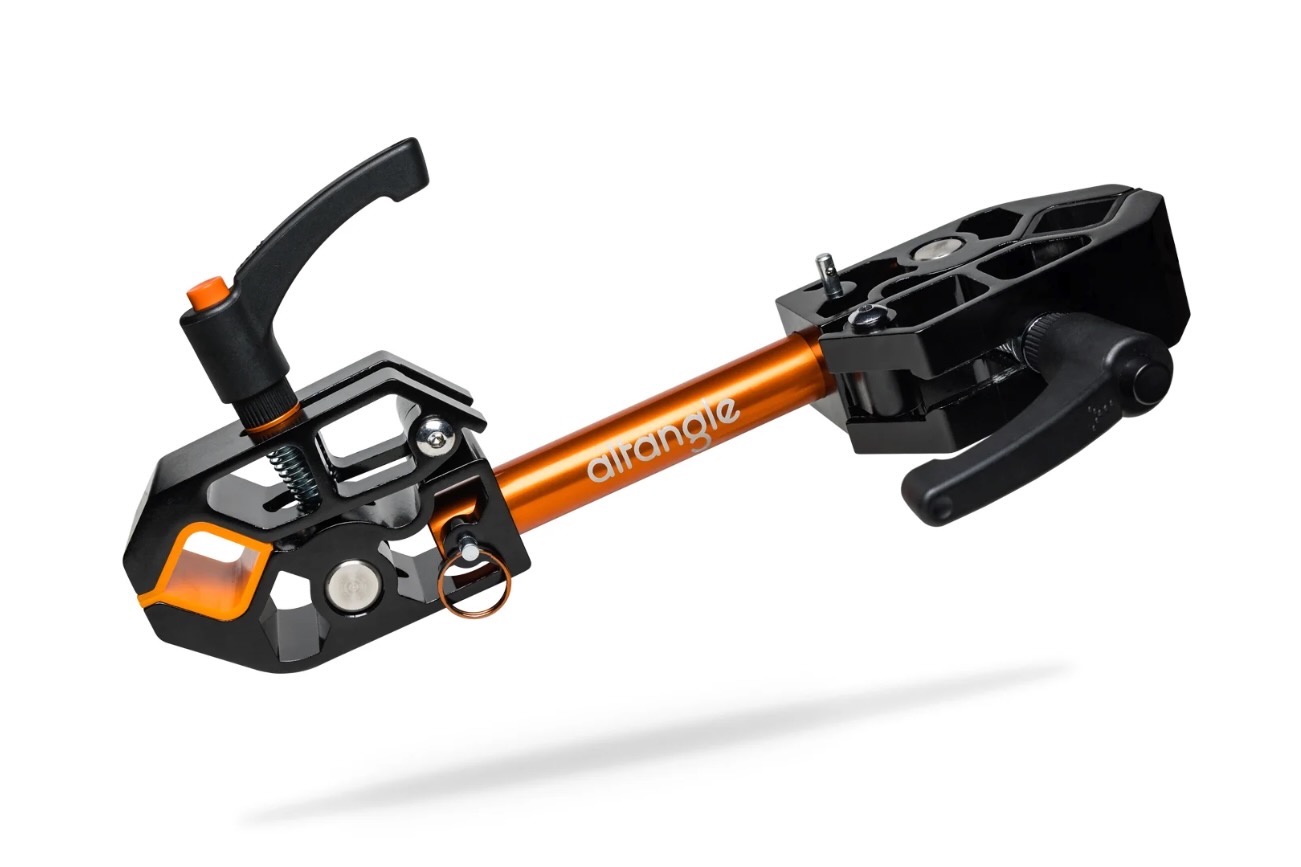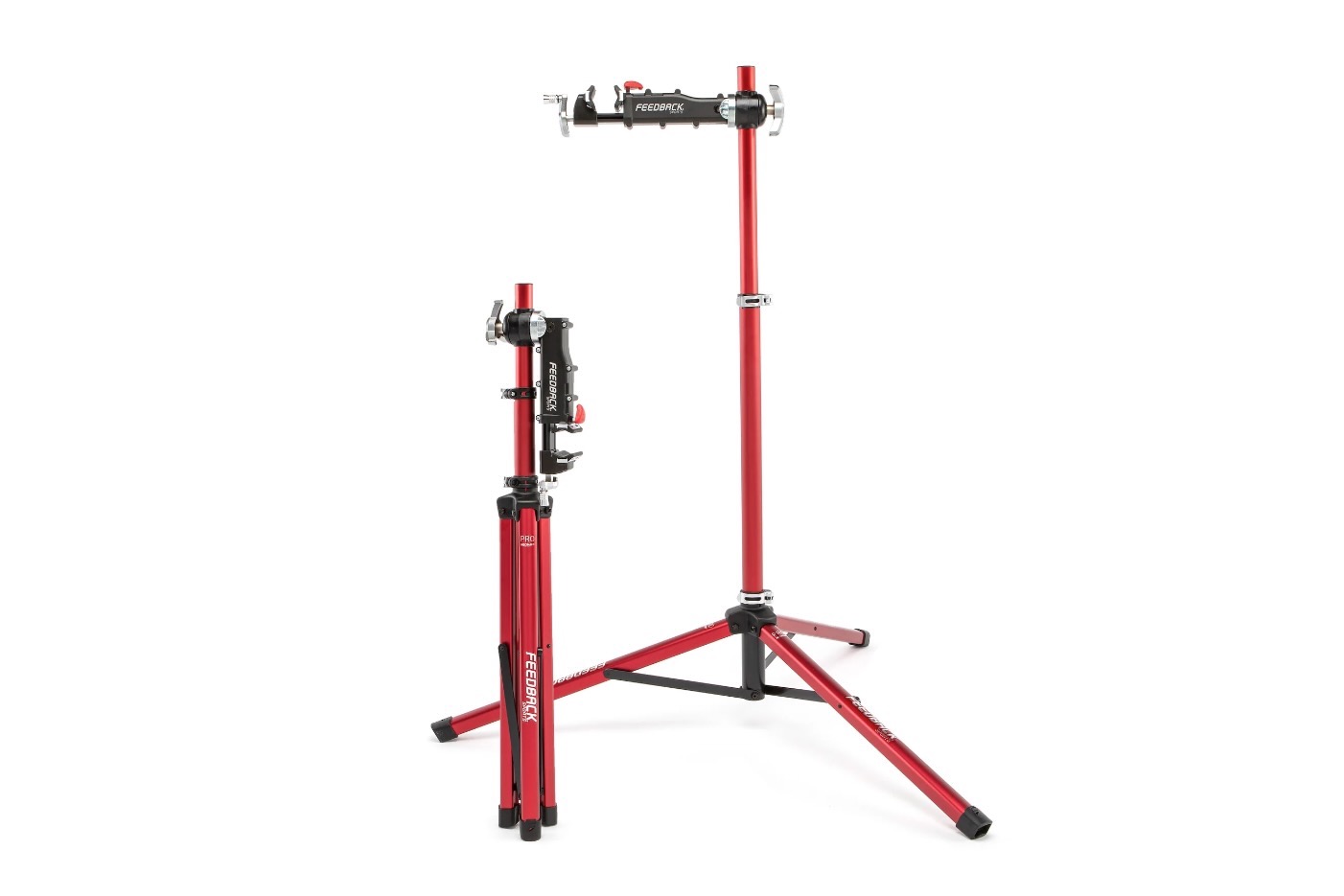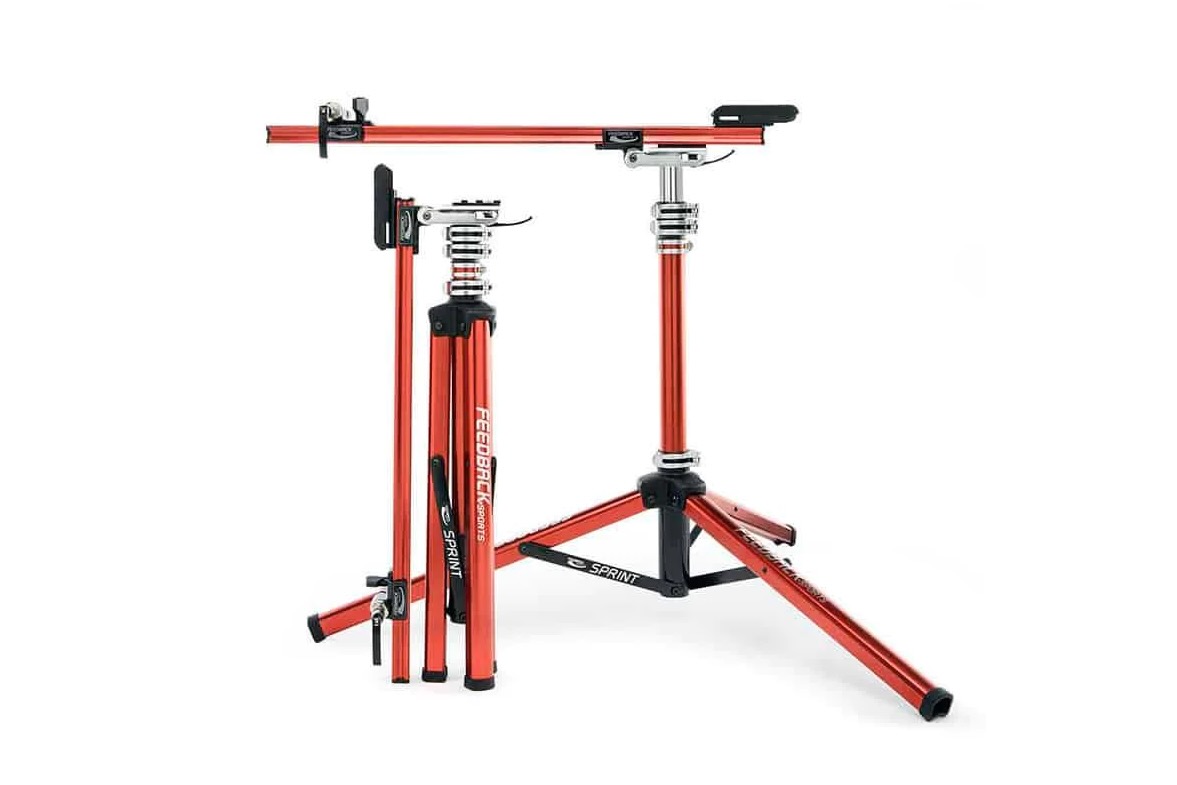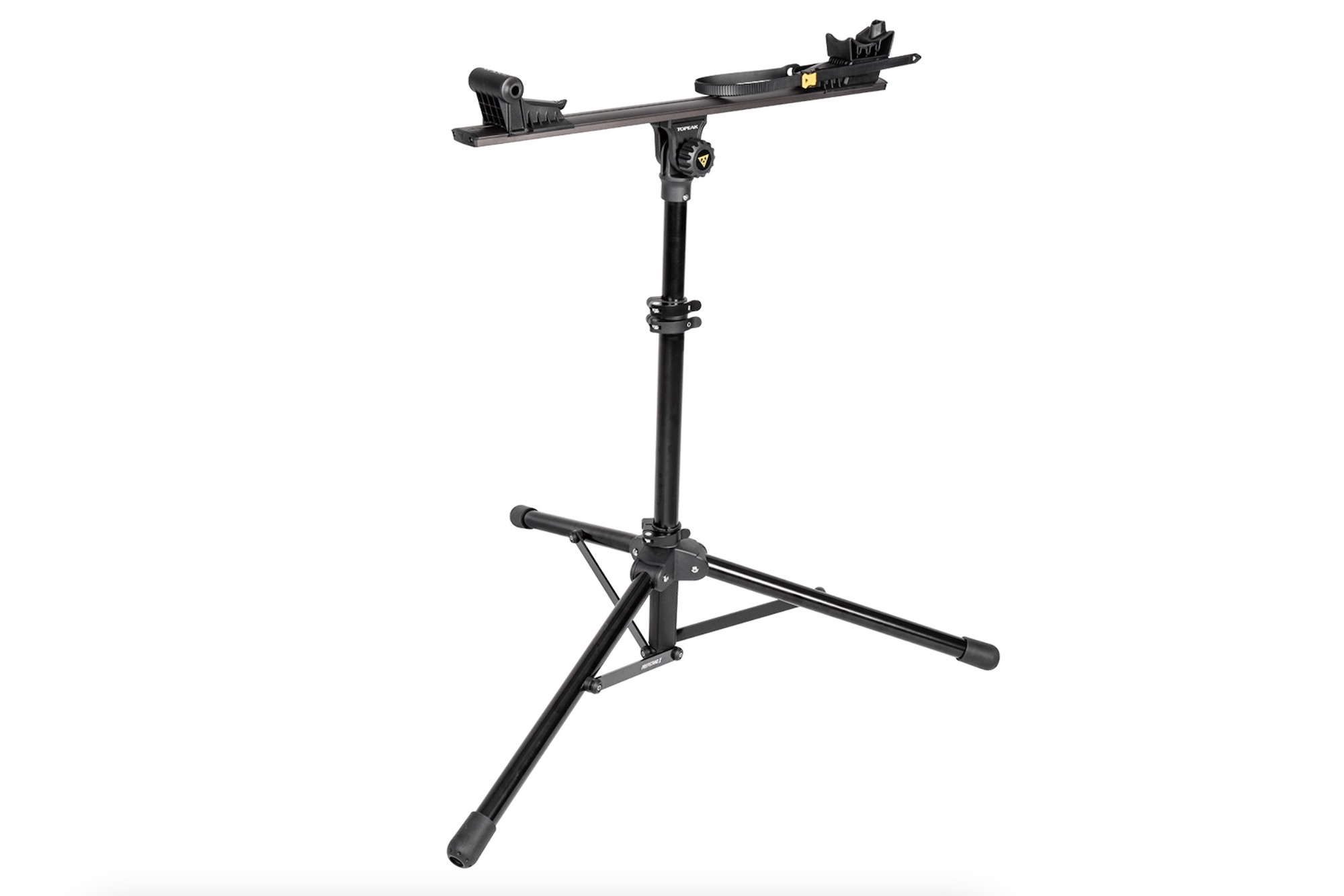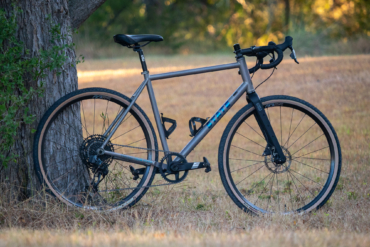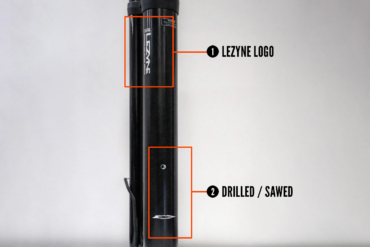A bike repair stand is a necessity for any cyclist who likes to work on their bikes at home or on the road. Whether you’re a casual rider who needs to clean your bike and lube phour chain or an experienced mechanic swapping parts and building new setups, a quality repair stand makes working on any bike quicker and easier.
We have tested dozens of bike repair stands including the best tube-clamp and Euro-style designs from the stable Park Tool Team Issue PRS-25, which boasts a high weight limit, to the compact and affordable Bike Hand.
We examine models based on stability, clamping mechanisms, ease of use, available adjustments, portability, and value to help every cyclist find the right bike repair stand to suit their needs.
Editor’s note: We updated this guide on October 29, 2025, with the addition of the field-tested and award-winning Feedback Sports Pro Mechanic HD Repair Stand.
The Best Bike Repair Stands of 2025-2026
Park Tool Team Issue PRS-25
- Type: Tube clamp
- Weight Capacity: 100 lbs. (45 kg.)
- Height Adjustability: 47" to 60" (119 cm to 152 cm)
- Stand Weight: 13 lbs.
- Folded Dimensions: 46.25" x 8.75" x 8.5"
Pros
- Very stable
- High weight limit
- Easy to set up
- Unique tube shape is very sturdy and prevents stand rotation
Cons
- Expensive
- Clamp head needs to be removed for most compact portable size (not difficult)
- Features like a tool tray would be nice for the price
Bike Hand Repair Stand
- Type: Tube clamp
- Weight capacity: 55 lbs. (other versions available)
- Height adjustability: 39" to 59"
- Stand weight: 11 lbs.
- Folded dimensions: 41" x 8" x 8"
Pros
- Lightweight
- Small collapsed size
- Affordable
- Heavy duty version available with 110-lb. weight limit
- Tool try included
- Easy setup
Cons
- Not as stable as competition
- Lots of plastic parts
Feedback Sports Pro Mechanic HD Repair Stand
- Type: Tube clamp
- Weight Capacity: 100 lbs. (45 kg.)
- Height Adjustability: 42" to 67"
- Stand Weight: 16.8 lbs.
- Folded Dimensions: 6.8" x 8.6" x 45.4”
Pros
- High weight ratio that's perfect for holding e-mountain bikes and tools
- Durable and corrosion resistant — great for outdoor summer storage
- Folds up to be very compact
- Push-button release for clamp provides easy one-handed use
Cons
- Extending the tripod legs is a bit sticky and cumbersome
- Expensive
Park Tool Deluxe Home Mechanic PCS-10.3
- Type: Tube clamp
- Weight Capacity: 80 lbs. (36 kg.)
- Height Adjustability: 39" to 57" (99 cm to 145 cm)
- Stand Weight: 16 lbs.
- Folded Dimensions: 43" x 14" x 10.25"
Pros
- Stable
- Tool tray included
- Quick, easy setup
- Moderate price point
- Sturdy and user-friendly clamp design
Cons
- Heavier weight
- Larger folded size
- Rotational clamp adjustment can be sticky
Park Tool Team Issue PRS-22.2
- Type: Axle/bottom bracket mount
- Weight Capacity: 60 lbs. (27 kg.)
- Height Adjustability: 30" to 45" (76 cm to 114 cm)
- Stand Weight: 12.5 lbs.
- Folded Dimensions: 33" x 7.5" x 9"
Pros
- No clamping on frame or seatpost tubes
- 360° rotation makes many tasks easier
- Good for working in small spaces
- Universal axle carriage, no adapters needed
- Easily portable for travel
Cons
- Expensive
- Needs to be adjusted to work with different bikes
ToPeak Prepstand Pro
- Type: Tube clamp
- Weight Capacity: 55 lbs. (25 kg.)
- Height Adjustability: 42" to 70" (107 cm to 178 cm)
- Stand Weight: 12.7 lbs.
- Folded Dimensions: 46" x 7" x 7"
Pros
- Integrated scale on clamp arm
- Included carry bag for easy and tidy transport
- Tall max clamp height
- Wide tripod base
Cons
- Expensive
- Clamp design is less user-friendly than others
Altangle Hangar Connect
- Type: Tube clamp
- Weight Capacity: Not specified
- Height Adjustability: Depends what you clamp onto
- Stand Weight: 3 lbs.
- Folded Dimensions: 14" x 6" x 2"
Pros
- Very lightweight and portable
- Functional repair stand anywhere there's something to clamp it onto
- Great as an extra hand in the workshop
- Useful for more than just bikes
Cons
- Requires something to attach clamp to for use
- Works best with lighter bikes
Other Bike Repair Stands We Keep in the Garage
- Type: Tube clamp
- Weight Capacity: 75 lbs. (34 kg.), "working load": 40 lbs. or less
- Height Adjustability: 42" to 67" (107 cm to 170 cm)
- Stand Weight: 12.6 lbs.
- Folded Dimensions: 45" x 8" x 5"
Pros
- Excellent, user-friendly clamp design
- Very quick to set up and break down
- Excellent finish quality and appearance
- Metal quick release collars
- Tall max clamp height
Cons
- Other options are slightly more stable
- Expensive
- Additional features like a travel bag or tool tray would be nice for the price
- Vertical support can be prone to rotating of not clamped tight enough
- Type: Axle/bottom bracket mount
- Weight Capacity: 85 lbs. (39 kg.), "working load": 40 lbs. or less
- Height Adjustability: 30" to 48" (76 cm to 114 cm)
- Stand Weight: 12.6 lbs.
- Folded Dimensions: 30" x 7.5" x 5"
Pros
- Comes with all the axle adapters you could need
- Excellent finish quality and looks
- Super stable
- Easily portable for travel
- Flat BB platform works well with a wide variety of frames
Cons
- Expensive
- No tray tilt adjustment
- No strap for BB included but would be useful
- Swapping out and centering adapters can be fiddly
- Type: Axle/bottom bracket clamp
- Weight Capacity: 39.7 lbs. (18 kg.)
- Height Adjustability: 33" to 57" (85 cm to 145 cm)
- Stand Weight: 11 lbs.
- Folded Dimensions: 34" x 9.8" x 6.3"
Pros
- No clamping on bike tubing
- Angle adjustable tray
- Integrated ratchet strap for BB area
- Adjustable fore-aft and 360° rotation
- Les expensive than similar options
Cons
- No rear axle mounting options included
- Fork mounts require adapters when switching between some bikes
Bike Repair Stand Comparison Chart
| Bike Repair Stand Model | MSRP | Type | Weight Capacity | Height Adjustability | Stand Weight | Folded Dimensions |
|---|---|---|---|---|---|---|
| Park Tool Team Issue PRS-25 | $473 | Tube clamp | 100 lbs. | 47″ to 60″ | 13 lbs. | 46.25″ x 8.75″ x 8.5″ |
| Park Tool Deluxe Home Mechanic PCS-10.3 | $280 | Tube clamp | 80 lbs. | 39″ to 57″ | 16 lbs. | 43″ x 14″ x 10.25″ |
| Bike Hand Repair Stand | $140 | Tube clamp | 55 lbs. | 39″ to 59″ | 11 lbs. | 41″ x 8″ x 8″ |
| Feedback Sports Pro Mechanic | $425 | Tube clamp | 75 lbs., “working load”: 40 lbs. | 42″ to 67″ | 12.6 lbs. | 45″ x 8″ x “5” |
| Park Tool Team Issue PRS-22.2 | $462 | Euro-style | 60 lbs. | 30″ to 45″ | 12.5 lbs. | 33″ x 7.5″ x 9″ |
| ToPeak Prepstand Pro | $540 | Tube clamp | 55 lbs. | 42″ to 70″ | 12.7 lbs. | 46″ x 7″ x 7″ |
| Altangle Hangar Connect | $265 | Tube clamp | not specified | N/A | 3 lbs. | 14″ x 6″ x 2″ |
| Feedback Sports Sprint | $375 | Euro-style | 85 lbs., “working load”: 40 lbs. | 30″ to 48″ | 12.6 lbs. | 30″ x 7.5″ x 5″ |
| ToPeak Prepstand X | $370 | Euro-style | 39.7 lbs. | 33″ to 57″ | 11 lbs. | 34″ x 9.8″ x 6.3″ |
| Feedback Sports Pro Mechanic HD | $525 | Tube clamp | 100 lbs. | 42″ to 67″ | 18 lbs. | 5″ x 8″ x 45″ |
How We Tested Bike Repair Stands
At GearJunkie, we take our recreation seriously, and for the cyclists on our team, that means maintaining and repairing our bikes so they run smoothly and we can perform at our best. For us, that includes having a good bike repair stand, saving time, money, and frustration. And, we want the same for you, so we take our product testing seriously to provide you with honest reviews to help steer you in the right direction when you’re looking for the best repair stand for use at home, on the road, or both.
Our Expert Testers
This bike repair stand buyer’s guide is a collaborative effort combining the expertise of three experienced bike mechanics and additional product testers. Collectively, our test team has over 60 years of experience using bike repair stands while working on bikes in their home workshops, doing routine maintenance, major repairs, and building bikes.
Paul Clauss tested the majority of the models in this review. Clauss is a mechanical engineer by trade and has experience working with 3D printing and CNC manufacturing processes for products, including bike frames and components. He’s also a skilled bike mechanic who prefers working on his own bikes and loves tinkering with things and scrutinizing the products he tests.
Today’s primary tester, Senior Editor Morgan Tilton, is based in Crested Butte, Colo., where more than 750 miles of mountain bike trails exist in the Gunnison Valley and surrounding area. She typically rides in Colorado and British Columbia and uses bike stands to maintain mountain bikes or e-mountain bikes.
Bennett Shane has over two decades of road cycling and bike mechanic experience. A former racer and obsessive rider, he’s also worked for numerous prominent brands in the cycling industry and has incredible knowledge of all cycling products from the inside out. He also owns and maintains a small fleet of high-end road bikes which he rides while testing a huge variety of cycling gear for Bikerumor and GearJunkie.
Former editor Jeremy Benson has been professionally testing and reviewing bikes and related accessories for eight years. He has personally tested and reviewed over ten bike repair stands during that time. While he wouldn’t call himself the best bike mechanic, he enjoys wrenching on his own bikes and the constantly revolving selection of test bikes that end up in his garage.
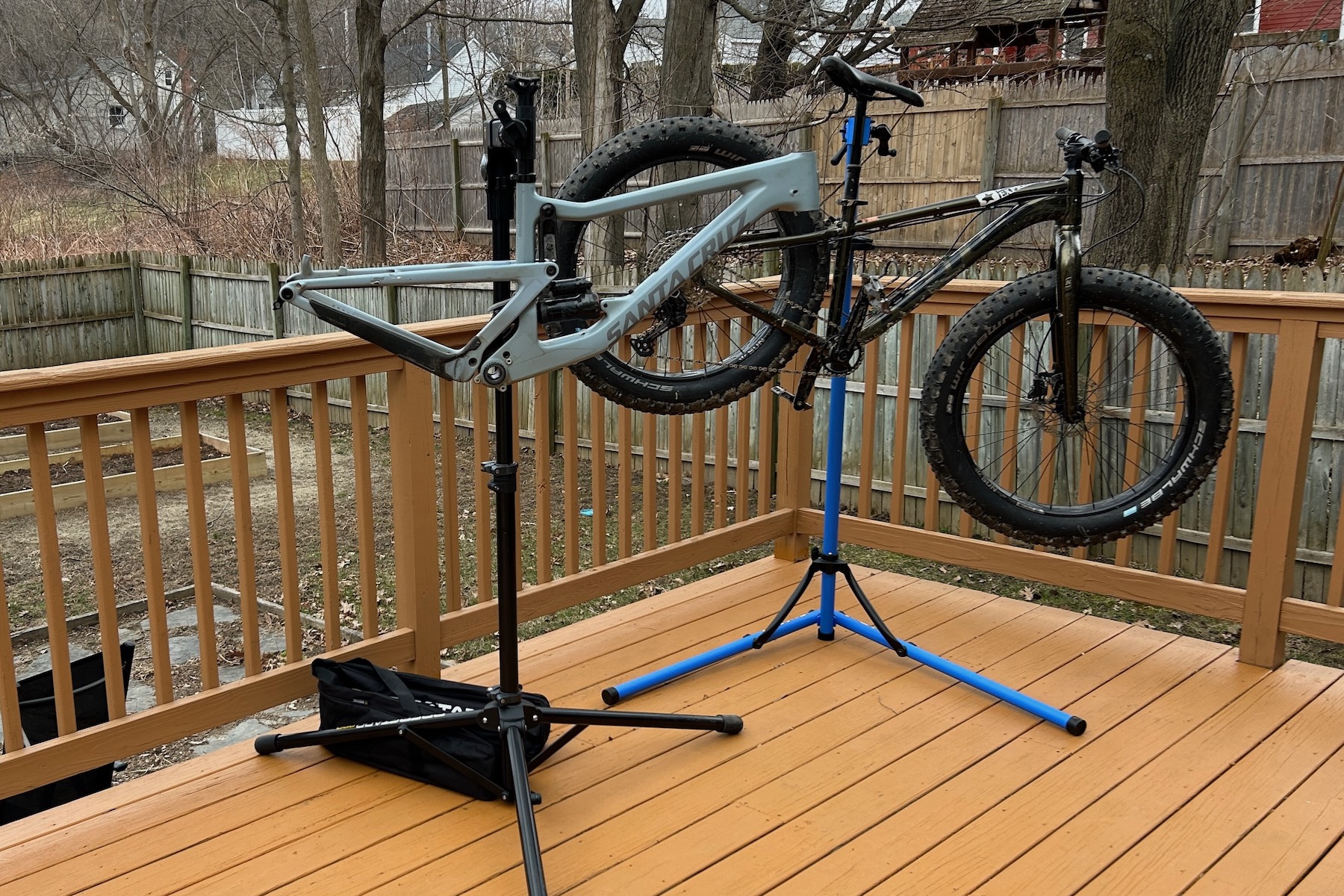
Our Testing Process
After rounding up nine of the best bike repair stands on the market, our team tested them for months to determine their strengths, weaknesses, and how they perform in the real world. Our test period happened to be during the depths of winter, giving us the opportunity to use them all extensively for full bike teardowns, major cleaning projects, and complete bike builds. Maintenance and repair tasks these stands were used for include but are not limited to:
- Swapping forks, brakes, dropper posts, wheels, and drivetrains between a Chromag hardtail and Santa Cruz Bronson (essentially tearing down and rebuilding two bikes — everything but pressing in headsets)
- A full tune of the resulting Chromag hardtail mentioned above.
- Completing setup of a new Santa Cruz Hightower (brake bleeds, dropper post installation, cockpit adjustments, GX AXS drivetrain adjustments and installation, frame protection tape installation).
- A full tune on a Bianchi cyclocross bike
- A full tune, dropper post-installation, and general maintenance on a Kona fat bike through winter use
- A RockShox Pike suspension fork rebuild
- Assembly and teardown of numerous test mountain bikes
- 10+ handlebar tape install and removals
- Routine maintenance on all of Paul’s, Bennett’s, and Jeremy’s bikes
During testing, we focused on important aspects of each bike repair stand’s performance, including setup, adjustments, clamp mechanisms, stability, weight limits, and portability. When testing wrapped up, we compared notes and zeroed in on our favorites and those that excel in specific ways compared to the rest.
Buying Advice: How to Choose a Bike Repair Stand
From simply fixing a flat tire to installing a new bottom bracket, a good work stand is a critical tool in your home workshop. There’s a lot to consider when choosing a bike repair stand. Here, we’ll break down the most important factors to help guide you in making a purchase decision. And, if you’re in the market for a new bike pump for the home workshop or a good multi-tool for use out in the field, we’ve tested and reviewed those, too.
Types of Bike Repair Stands
The first consideration when purchasing a bike repair stand is choosing the right type for you and the bikes you’ll be working on. We tested both the more traditional tube-clamp style and Euro-style (axle/bottom bracket mounting) options. Both have their pros and cons.
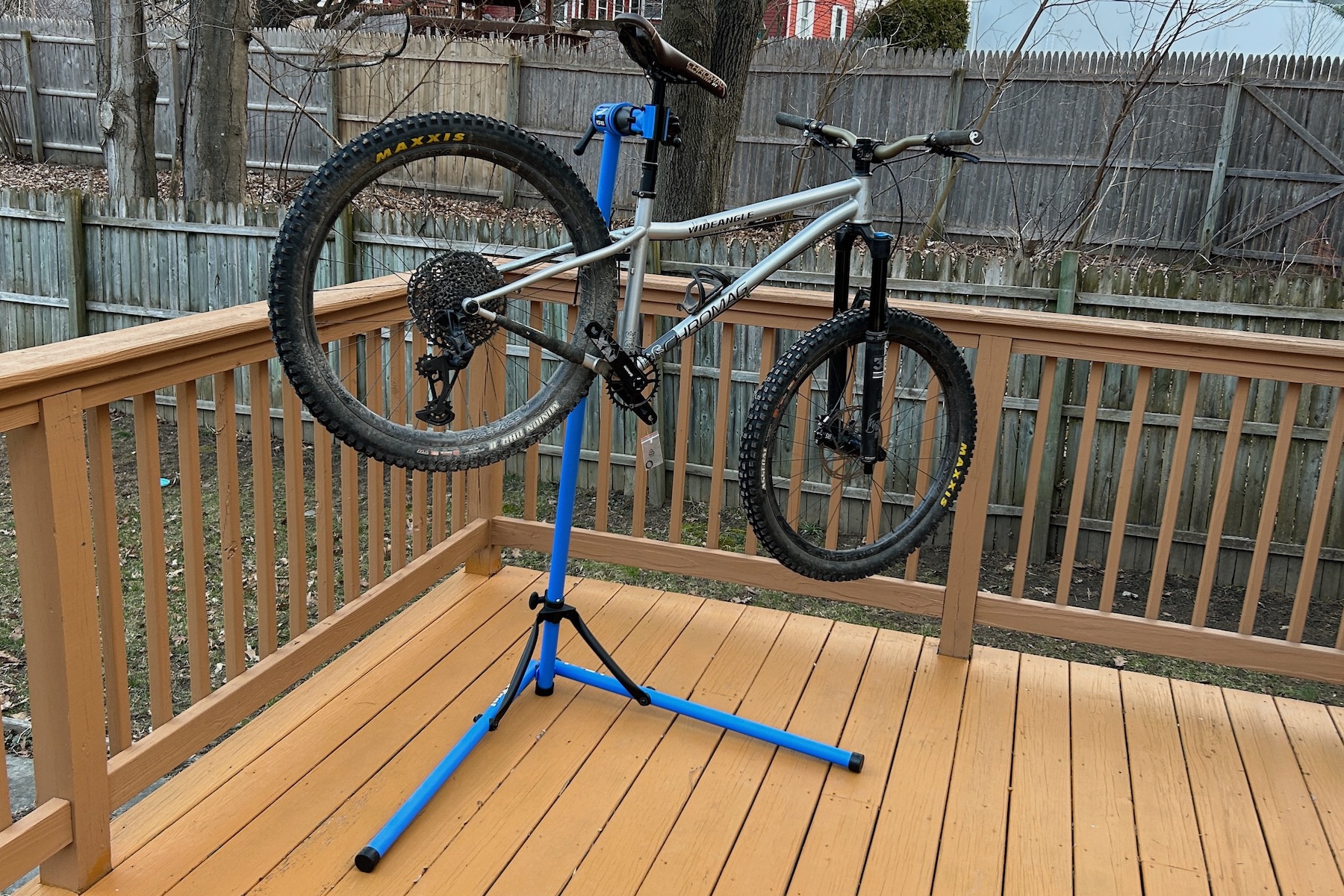
Tube Clamp
When you go into most bike shops, you’ll see traditional tube-clamping stands. These types of repair stands hold the bike with a set of jaws that clamp around your bike’s tubing, preferably the seatpost. As such, they are impressively versatile in terms of bike fit and will work with most bikes except for some with very oddly shaped tubing (like aero seatposts).
They are quick and easy to use — no need to remove any wheels to throw your bike on the stand to lube the chain or clean it after a ride. They almost always have height adjustability to dial in the clamp height to your needs, and most also feature rotation to adjust the angle of the clamp (and the bike in it) for weight distribution or easier access to certain parts. The options we tested have either tripod-style legs or two legs that fold out from the main support for three points of contact.
Unlike dedicated shop repair stands, the portable models we tested all fold down to a more compact size for storage or travel. That said, they are generally a little bit larger than their Euro-style counterparts. The main reason that some riders avoid tube-clamp repair stands is that they clamp to the bicycle seatpost or frame. Those with potentially fragile frames or oddly shaped tubing may prefer the lack of frame contact provided by the other style.
We tested the best portable tube-clamp options on the market, including the Park Tool PCS-10.3 and PRS-25, the Feedback Sports Pro Mechanic, and the Topeak Prepstand Pro, as well as the super affordable Bike Hand repair stand.
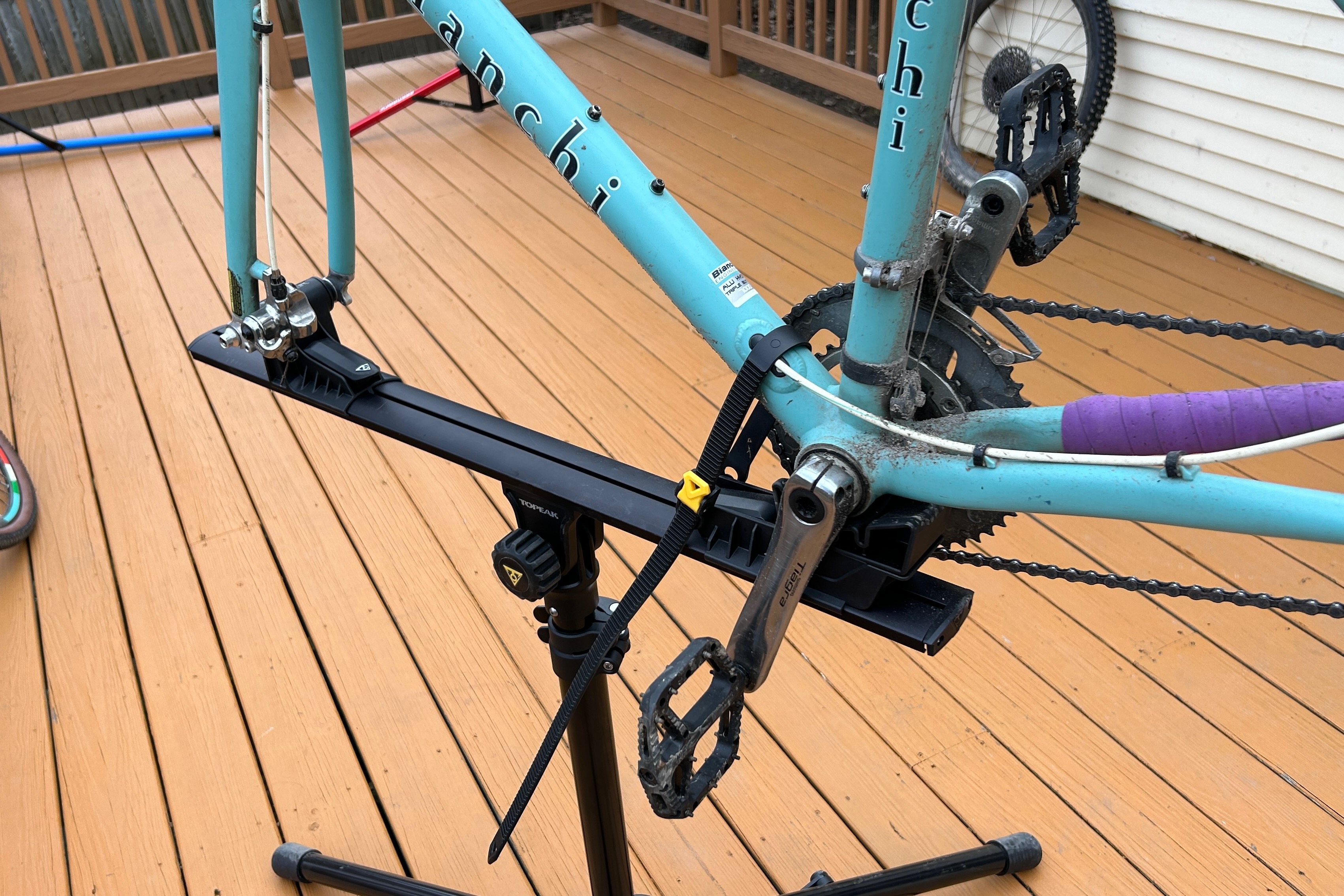
Euro-style: Axle/Bottom Bracket
Euro-style stands do not clamp onto the bike, instead, they support it on a horizontal tray on a bottom bracket cradle and an axle “carriage.” This style of repair stand has traditionally been most popular with road riders and triathletes who have super lightweight frames or oddly shaped aerodynamic tubes that may be susceptible to damage from clamping force or may not fit into tube-clamp stands.
In addition to not clamping the frame, Euro-style stands are quite stable, with the bike slightly lower to the ground and the weight centered above the main support and tripod footing. They also allow the bike to be spun 360° like a carousel, making it possible to access different sides of the bike without having to move around it. They also tend to be relatively lightweight and fold down slightly smaller than tube-clamp models for travel.
While we don’t love having to remove a wheel to attach the bike by an axle for every basic maintenance task, Euro-style stands are preferred by many users. The Feedback Sports Sprint, Topeak Prepstand X, and the Park Tool Team Issue PRS-22.2 all fit into this category.
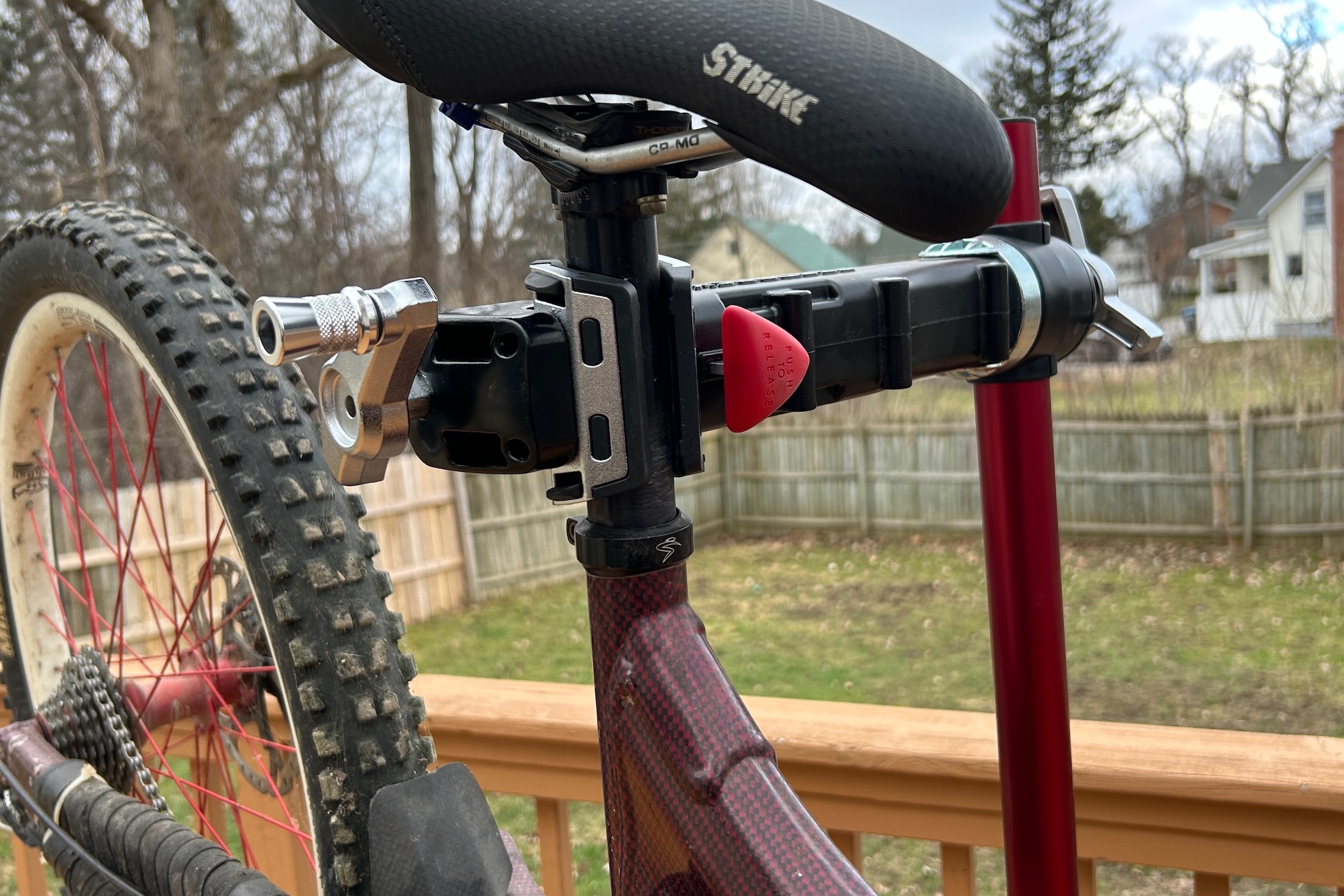
Clamps
Every time a bike repair stand is used, the clamp will be used at least once. It is important that the clamp mechanisms hold tightly enough to keep the bike in position and on the stand but also not to have a clamp that exerts too much force and risks damaging frames and components.
Tube-clamp stands use a variety of different clamp styles, and higher-end models generally include an upgraded mechanism for ease of use (clamping and releasing). The Park Tool PCS-10.3 and PRS-25 use basic cam levers, which are familiar and extremely easy to use with one hand.
The Feedback Sports Pro Mechanic clamp takes it a step further, and its ratcheting jaws can be pushed in easily, tightened quickly, and released with a quick press of a large release button. The Topeak Prepstand Pro uses a plastic knob with a foldable lever to manually tighten and loosen the clamp jaws. While totally functional, it isn’t quite as user-friendly as the aforementioned clamp designs on the Park Tool and Feedback Sports models.
Bikes mount to Euro-style stands by the front or rear axle in a “carriage” and rest on a cradle at the bottom bracket area. Some models also include a strap to hold the bottom bracket down into the cradle for extra security. This requires a wheel to be removed and, in most cases, axle adaptors to be set up when switching between bikes with different axle sizes.
Be sure to check that the adaptors included with a tray stand will work with your bikes. Most modern stands will work with the most common axle sizes on modern road, gravel, and mountain bikes.
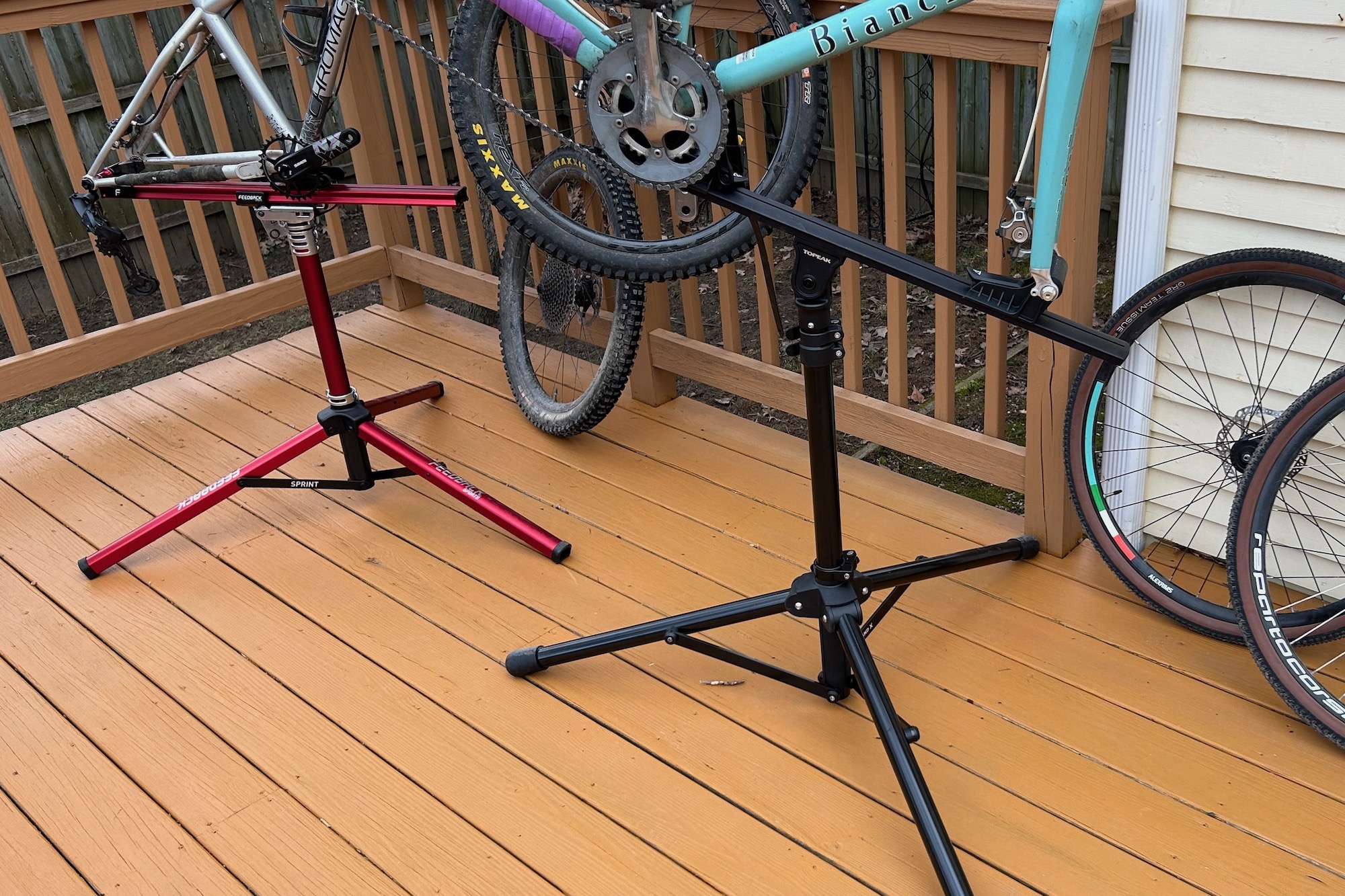
Stability
If you’ve ever had to fight to loosen a stubborn crank bolt, remove a seized seatpost, or remove a pair of pedals, you already know how important stability is in a bicycle work stand. Repair stand stability is impacted by many factors, including design, foot spacing and shape, height, tube stiffness, and weight of the bike and how it’s positioned. A more stable stand is safer (for you and your bike), and anyone with a heavier e-bike should certainly be looking for a very stable stand with a higher weight limit.
Euro-style style stands are very stable, as they center the bike directly above the main support and footing of the stand, as well as mounting directly to a dropout. Tube-clamp stands are also generally quite stable, but we found the Park Tool PRS-25 and PCS-10.3 to be the most stable due to their shaped tubing (to reduce rotation and flex in the stand) and wide dual-leg footing designs, which allow the bike to stay centered over the triangle they form.
The ToPeak Prepstand Pro and Feedback Sports Pro Mechanic are also very stable, but their round tubing allows for a bit of rotation which can move the weight away from the most stable position. If you are paying attention, this isn’t really an issue at all but may require repositioning from time to time.
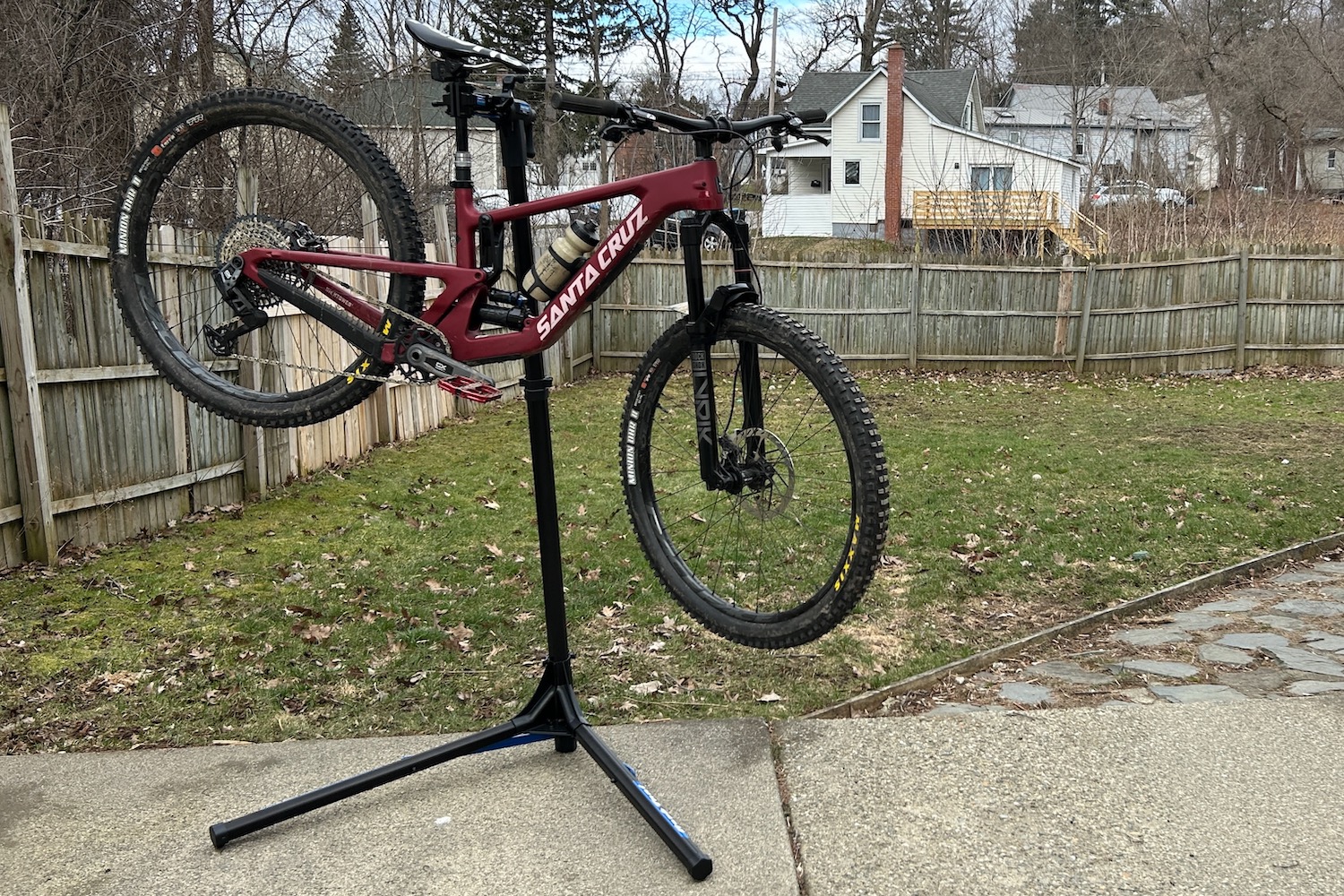
Adjustments
Bicycle repair stands offer a wide variety of adjustments to position the bike properly for any repair. These adjustments can differ between stands and styles. Adjustments are usually controlled by knobs and/or quick releases, and some (particularly height) should be made before the bike is clamped to the stand.
All of the models we tested for the traditional tube-clamp stands allowed us to adjust the clamp height and rotate the clamp arm 360 degrees, which was plenty to get the bike in a good position for any task we encountered, no matter the stand.
If you are exceptionally tall, the Topeak Prepstand Pro and Feedback Sports Pro Mechanic had the tallest available clamp heights, at 70” and 67”, respectively. Just remember that the higher the clamp arm is positioned, the less stable the stand becomes.
The Euro-style stands we tested differed more in available adjustments. All of them included height, fore-aft position (through the tray itself and the dropout and BB mounts on the tray), and rotational tray adjustments with solid quick-release mechanisms. While the Feedback Sports Sprint was limited to these adjustments, the Topeak Prepstand X and the Park Tool PRS-22.2 also allow the tray to be tilted — a welcome feature when bleeding brakes or finalizing cockpit setups on this style of work stand.
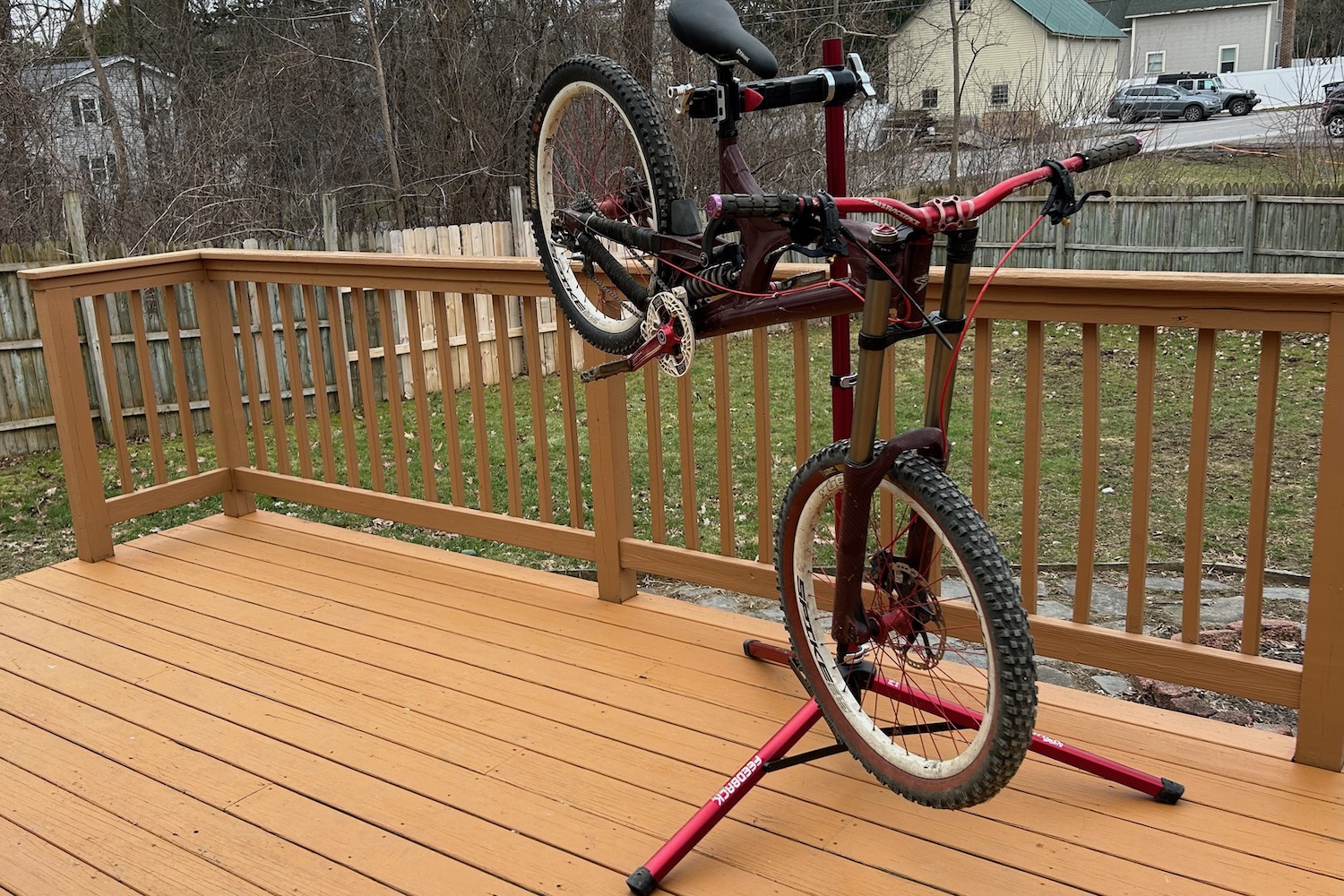
Weight Capacity
Weight capacity is an important consideration when choosing the right bike repair stand. Most models can easily handle the weight of most non-electric road, gravel, and mountain bikes (approximately 20 to 40 pounds), and many are rated to hold heavier bikes as well. This is good considering the growing popularity of heavier-weight electric bikes, as we need to be able to work on them, too.
The Euro-style stands range between 40 lbs. (Feedback Sprint and ToPeak Prepstand X) and 60 pounds (Park Tool PRS-22.2). And even though the Park Tool PRS-22.2 could handle some heavier e-bikes, loading them onto a Euro-style stand isn’t ideal. The tube-clamp models all claim to be able to handle a bit more weight, with the models we tested ranging between 55 pounds and 100 lbs. Both the ToPeak Prepstand Pro and the Bike Hand Repair Stand are at the lower end of that range, and at 55 lbs., they can realistically handle most bikes other than heavier e-bikes. Keep in mind that maxing out the weight limit of a bike stand will decrease its stability, especially once you start torquing on it.
The two Park Tool tube-clamp models we tested, the Deluxe Home Mechanic PCS-10.3 and the Team Issue PRS-25, are rated to handle bikes up to 80 lbs. and 100 pounds, respectively. That, along with their shaped tubing that prevents them from rotating, makes them both great options for heavier bikes. Additionally, Feedback Sports makes the Pro Mechanic HD ($495), and Bike Hand makes a Heavy Duty version ($200) of their repair stand that are rated for 100 pounds and 110 pounds, respectively.
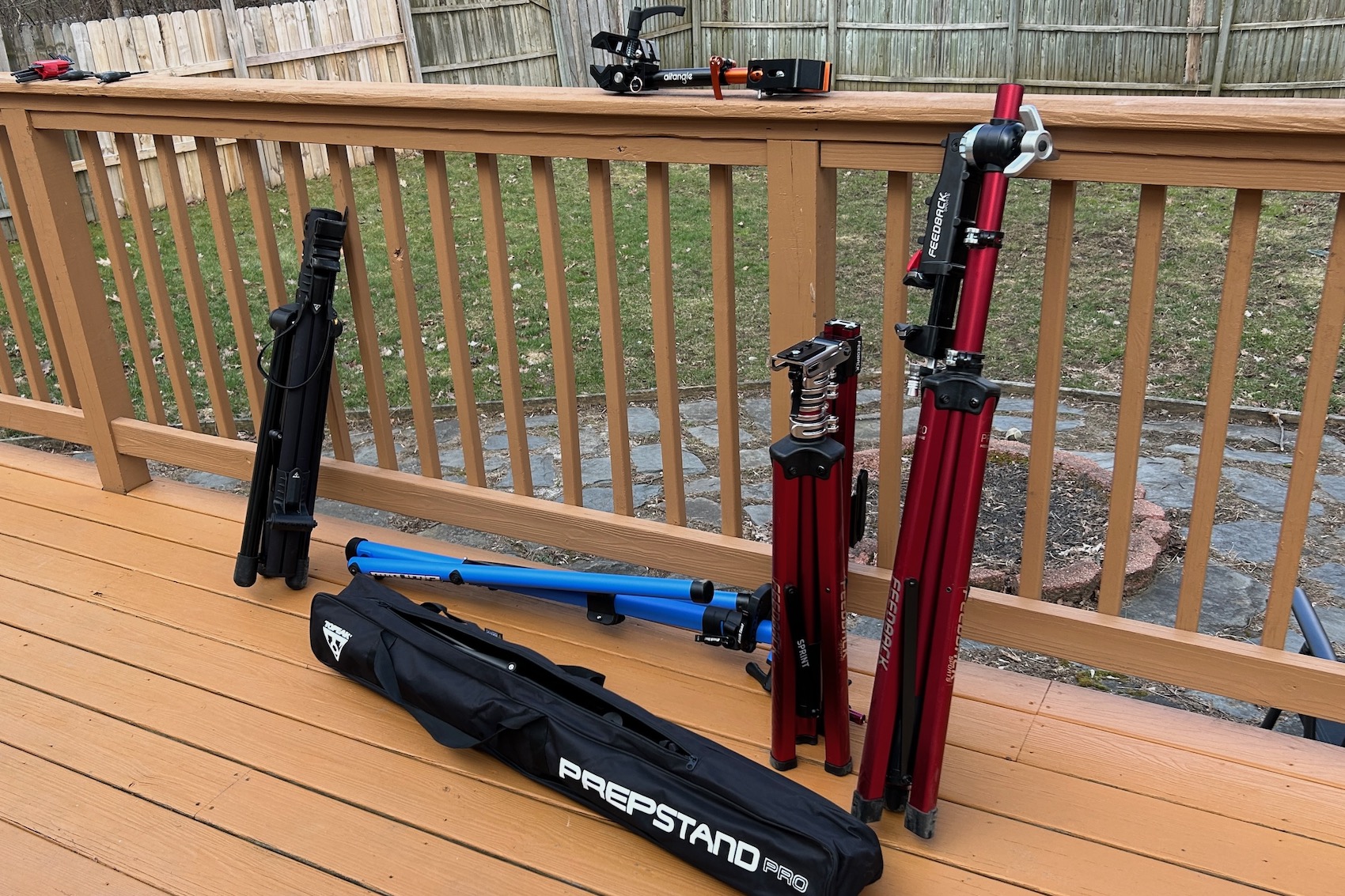
Portability
The primary factors to consider related to portability are weight and folded dimensions. All of the stands we tested are foldable and portable to some degree. The real standout here is the Altangle Hangar Connect, with a weight of just 3 pounds and dimensions of 14″ x 6″ x 3″. It requires a sturdy object or tube to clamp it onto, but it’s so tiny you can even pack it in your bike travel bag for a flight.
Of the freestanding models, the Euro-style stands make the most compact packages when not in use. They take up very little storage space and easily fit into the trunk of your car to bring with you on the road. While they are a tiny bit bigger, all of the tube-clamp models are relatively compact when folded, too. The Park Tool PCS-10.3 was the heaviest and largest, but even then, at 16 pounds, it’s still easy enough to carry around and throw in the car when needed.
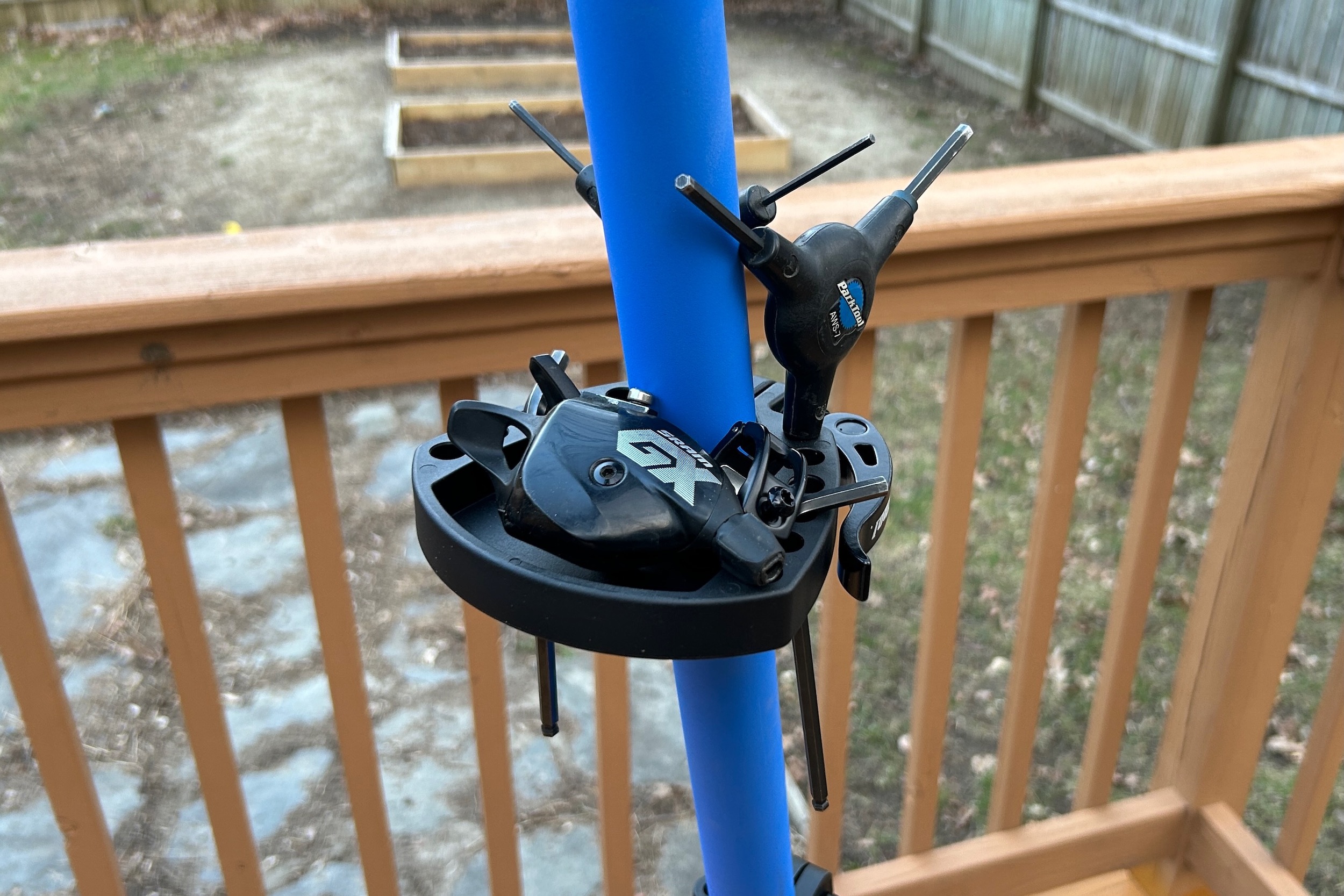
Accessories
Bike repair stands are a home workshop and travel accessory in and of themselves but their functionality can often be improved with accessories. Our favorite repair stand accessory is an attachable tool/small parts tray, which was only included with the budget-friendly Park Tool PCS-10.3 and Bike Hand models.
Most brands offer a range of accessories, including tool trays, though you will typically need to purchase them separately. Trays are a great addition to any bike stand because they allow you to keep small parts (bolts) and tools within reach when at the stand.
To effectively work on your bikes at home, you’ll also need tools. Bike multitools are a good option, but we prefer using separate tools when working on bikes at home. While you can build up a good tool collection over time, it’s often the easiest to purchase a whole set to cover all your bases right off the bat. Park Tool’s Home Mechanic Starter Kit ($200) or Feedback Sports Team Edition Tool Kit ($350) are both great options for home or travel that have most of what you need and will help keep it organized too.
If you will be traveling with your repair stand, a carrying case or bag can be purchased for most of the stands we tested. The only stand we tested that included a bag was the Topeak Prepstand Pro, which was great for throwing it in the back of the car without needing to worry about it being scratched (or scratching other items) or snagging on other gear.
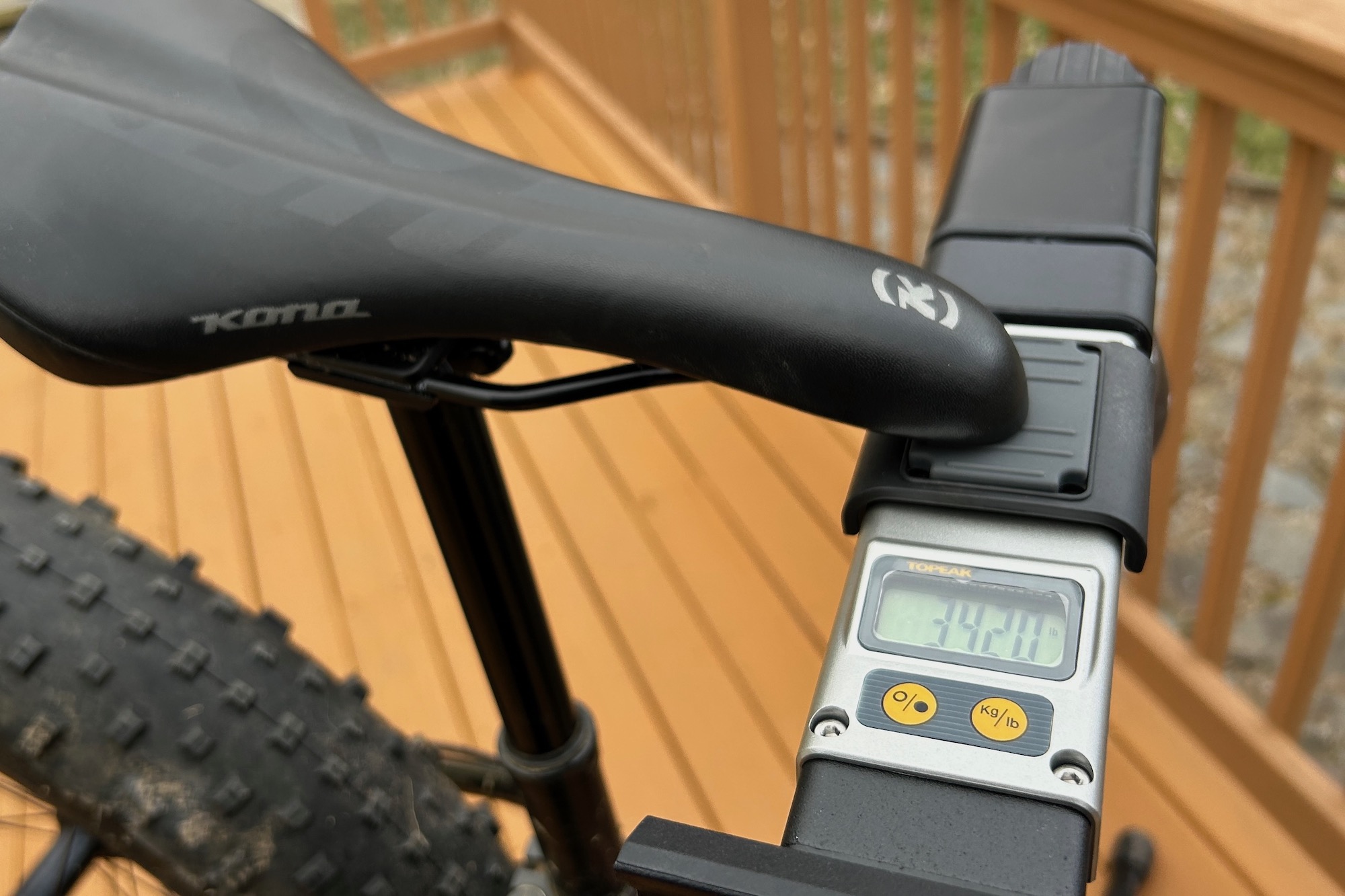
Price & Value
The bike repair stands we tested range in price from around $100 to over $400. As the price goes up, so does the quality of materials, build, finish, features, and ease of use. Given the fact that a bike repair stand can save you lots of frustration and quickly pay for itself in money saved from doing maintenance and repairs at home, we feel it is generally money well spent. Plus, in our experience, these things usually provide many years of faithful service.
Budget
Even the least expensive option, the Bike Hand Repair Stand ($140 but usually on sale for $100), is perfectly functional and gets the job done. The tubing is thinner, and there is quite a bit of plastic in its construction, but we’ve been using ours for over 5 years, and it still works great. As long as you don’t exceed its weight limit or treat it carelessly, this repair stand is a real bargain, even if it’s a little clunky.
Mid-Tier
If you’re not willing to pay top dollar for a premium model, the Park Tool Deluxe Home Mechanic PCS-10.3 ($280) is our recommendation. Functionally, it’s nearly identical to its more expensive sibling and only suffers slightly in terms of portability, with a few pounds of extra weight and a slight reduction in its weight capacity.
In the mid-tier we’ve also got the Altangle Hangar Connect ($265). This ultra-portable option stands out for it’s compact size, light weight, and impressive versatility. You’ve basically got a repair stand anywhere you can find a spot to clamp it onto. Creating such an impressive little unit isn’t easy, however, so it’s not surprising that this highly engineered product costs as much as it does.
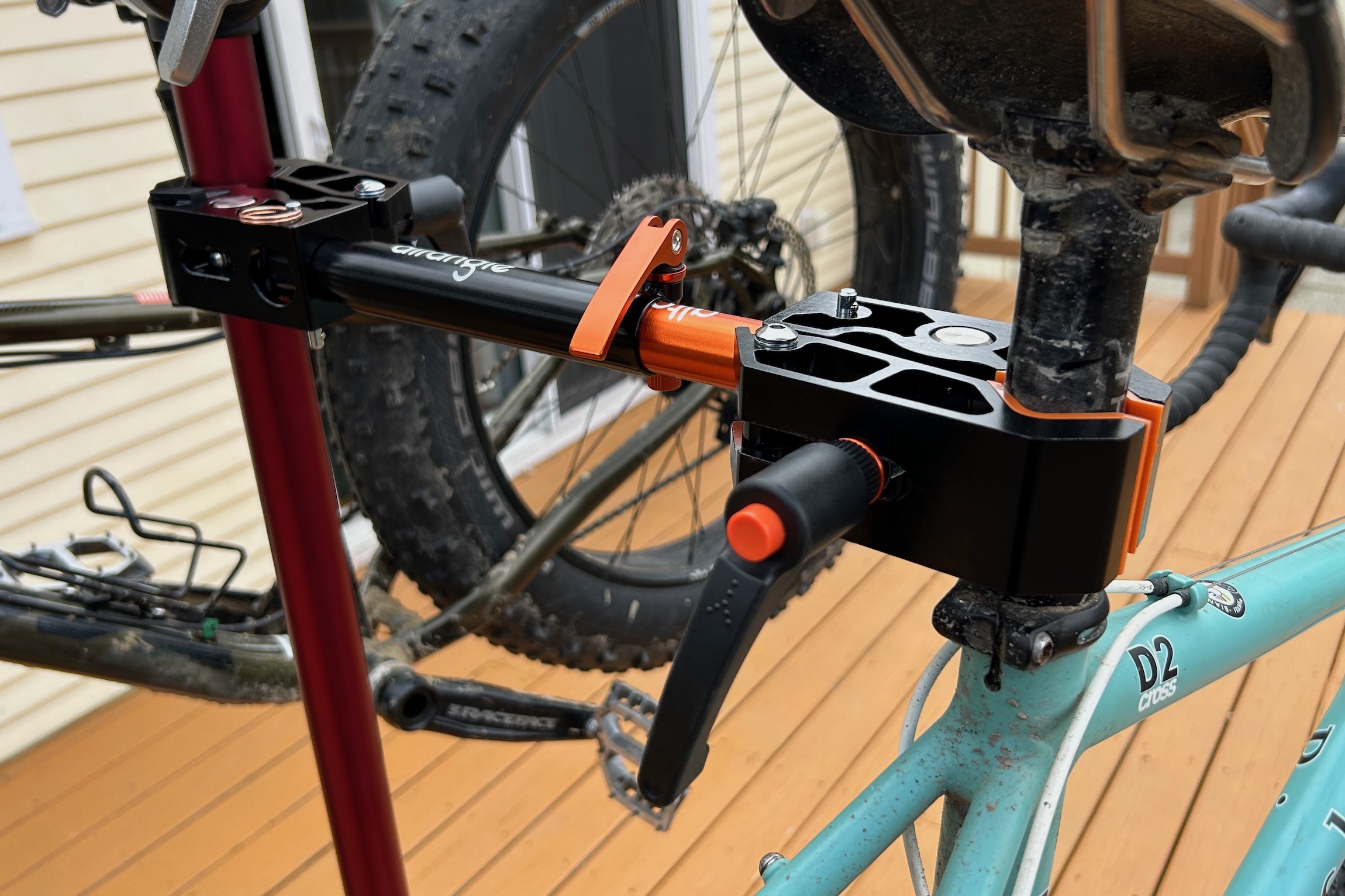
Premium
With functional stands like the Bike Hand costing around $100, it’s fair to wonder why so many others cost 4 times as much. In the premium price range, we’ve got stands that are made from higher-quality materials with better stability, higher weight limits, better clamps, and some with additional features. Our top-rated bike repair stand, the Park Tool Team Issue PRS-25 ($430), is designed with specially shaped tubing and a super sturdy clamp to support up to 100 pounds, yet it still weighs only 13 pounds. Striking that kind of balance isn’t easy, and that’s reflected in the high price.
The Feedback Sports Pro Mechanic ($395) stands out for its best-in-class clamp design that makes loading and unloading a bike as user-friendly as it can be. The ratcheting, quick-release clamp, all-metal hardware, and impressive performance of this stand make it far and away one of the easiest to use. The ToPeak Prepstand Pro ($430) commands its high price due to the fact that it has impressive stability and comes with features like an integrated digital scale and a handy storage/carrying bag.
Euro-style work stands, like the Park Tool Team Issue PRS-22.2 ($420) we tested, all land in the premium price category as well. While they might seem less complicated than the tube-clamp style, there’s actually a lot that goes into them. Not only do they have trays to support the bike, but they also need clamps for the axles, the ability to swivel/rotate, and, in some cases, for the tray to tilt as well. Once you factor in the need for them to fold up into a small package, it’s easier to see why they cost so much to design and produce.
Frequently Asked Questions
If you’ve ever worked on your bike while it’s leaned against a wall or flipped upside down, then you know it can be a lesson in frustration. Picking your bike up off the ground and holding it steady with a repair stand makes everything so much easier.
Whether you’re doing routine maintenance tasks like cleaning your bike or lubing your chain or diving into bigger projects like replacing cables, bleeding brakes, or building bikes, a repair stand allows you to adjust your bike’s position to optimize it for the task at hand.
And, while a good repair stand will cost you a bit of money upfront, it will likely save you money in the long run. Having a quality repair stand makes it so much quicker and easier to work on your bike that you’re probably more likely to do it and increase your mechanic skills.
Parts still cost money, but you’ll save on labor costs and definitely save time by avoiding going back and forth to the shop. Depending on the job, you may also avoid having to wait for days or weeks for the shop to fix your bike. More time riding!
All of the work stands we’ve included here are also portable. Not only are they a great addition to your at-home workspace, but they can also be brought along on road trips to keep your bikes running smoothly.
Honestly, all of these bike repair stands work well and are so much better than not having one at all. The best one for you, however, depends on the bikes you have and your specific needs. Do you most wrench on high-end road bikes?
A Euro-style stand might be the best fit to avoid any clamping of tubes. Of the models we tested, we feel the Park Tool PRS-22.2 is the best, but the Feedback Sports Sprint and ToPeak Prepstand X are both great as well.
For the tube-clamp models, consider your bikes’ weights and choose accordingly. Will you be wrenching on heavy e-bikes? If so, go with a stand with a higher weight limit like the Park Tool PRS-25 or PCS-10.3. Interested in an awesome-looking stand with the most user-friendly clamp design?
The Feedback Sports Pro Mechanic has you covered. Are you flying somewhere with your bike and need something to bring with you, a super portable option for car camping, or an extra hand in the at-home workshop? Check out the Altangle Hangar Connect.
Price is another consideration. In our opinion, the Park Tool Deluxe Home Mechanic has the best price-to-performance ratio. It weighs just three pounds more than the more expensive PRS-25, but it functions nearly identically while costing quite a bit less.
Choosing between the different styles of repair stands really depends on your specific needs. Generally speaking, we find the tube-clamp style stands to be a bit more versatile and user-friendly. They’ll work with virtually any bike, loading and unloading bikes is super quick and easy, and doesn’t require the removal of a wheel.
That said, they do clamp onto your seatpost or frame (we always recommend the seatpost if possible), so they may not be compatible with oddly shaped tubes or could potentially damage fragile tubing if over-tightened.
Euro stands have their advantages as well. They are super stable, allow the bike to spin 360° for easy access to both sides, and they don’t clamp onto the frame or seatpost. You’ll often see these in the pits of professional road bike races as they are typically preferred by road bike mechanics or those wrenching on high-end, lightweight road and triathlon bikes. If you are scared of clamping onto your super high-end road frame or you have an aero seatpost, this is the way to go.
We recommend always clamping to the seatpost while using a tube-clamp repair stand. Make sure the seatpost collar is tightened to keep the frame from rotating and so the frame doesn’t slip off.
No frame manufacturers recommend clamping to frames of any material. It is possible to damage a bike frame clamping directly to it, especially if the clamp is over-tightened. As a general rule, try to avoid clamping to your frame.
Clamping to dropper post stanchions is a tricky subject and, to be honest, we usually just watch our clamping torque and do it for quicker repairs or maintenance. We may find ourselves pulling out enough of the dropper post lower to clamp to for longer repairs or if we are really torquing on a crankset, but this is pretty rare.
It is worth noting that most dropper post manufacturers do not recommend doing this, and, if our soft jaws are at all beat up or have sharp edges, we will wrap the dropper post stanchion with a rag before clamping it. If you choose to follow our cavalier approach here, be sure to limit your clamping torque and ensure the jaws are clean/wrap the stanchion in a rag to avoid damaging your seat post.
Euro-style stands make clamping low risk by using the front or rear axle and the bottom bracket resting in a cradle. Again, if you have a super lightweight race bike or oddly shaped tubing, this style of stand takes the stress out of putting it in a repair stand.
E-bikes are heavier than human-powered bikes, due to the addition of a large battery, motor, and burlier construction. This means they are harder to lift onto a stand, as well as more difficult to hold in a stand. While the Altangle Hangar Connect might be a good travel option and does not provide a weight limit, we probably wouldn’t recommend it for working on a 50-pound e-bike — particularly because you’d also need to be very careful about what the Altangle was attached to.
The Euro-style stands we tested top out for recommended weight at around 40 lbs, which limits their use with most e-bikes. It’s also worth considering that you’ll need to remove at least one wheel and lift the frame onto the tray, which takes some effort.
The tube-clamping stands had maximum weight ranges of between 55 pounds (the Topeak Prepstand Pro) and 100 pounds (the Park Tool PRS-25), but are designed optimized to work best with likes under approximately 40 pounds. If you expect to be working with heavier e-bikes, very stable options like the Park Tool PCS-10.3 and PRS-25 are a good starting point, and it could be worth looking at non-portable stands like the Park Tool PRS-3.3-2 (or similar), which can be bolted to a heavy, sturdy base.
If the ability to travel with your bike stand is of the utmost importance, the Altangle Hangar Connect is by far the most portable option. The only caveat is that it is not freestanding, and it requires a sturdy pole (or similar) to clamp onto for use. Still, at 3 pounds and with small dimensions of 14″ x 6″ x 3″, it can be stashed in your bike bag for a flight and takes up almost no room in your vehicle if you’re on the road.
If you’re not flying, all of the other stands we tested are also relatively portable as they fold down to reasonable sizes that make them pretty easy to stash in your trunk or a roof box for travel on the road. None of them are prohibitively large or heavy. That said, all of the Euro-style stands fold down a little bit smaller and are on the lighter end of the weight spectrum, while the tube-clamp models tend to be a little bit longer overall.
Related Content

The Best Bike Pumps of 2025
We tested 16 models from top brands like ToPeak, Blackburn, Silca, Bontrager, and more to find the best bike pumps.

The Best Hitch Bike Racks of 2025
We tested the best hitch bike racks for 2025 with options for every budget. Top picks include Thule, Kuat, RockyMounts, and more.
